
Home » Education » What is the Difference Between Assignment and Assessment

What is the Difference Between Assignment and Assessment
The main difference between assignment and assessment is that assignments refer to the allocation of a task or set of tasks that are marked and graded while a ssessment refers to methods for establishing if students have achieved a learning outcome, or are on their way toward a learning objective.
Assignments and assessment are two important concepts in modern education. Although these two words are similar, they have different meanings. Assignments are the pieces of coursework or homework students are expected to complete. Assessment, on the other hand, refer to the method of assessing the progress of students. Sometimes, assignments can act as tools of assessment.
Key Areas Covered
1. What is an Assignment – Definition, Goals, Characteristics 2. What is an Assessment – Definition, Characteristics 3. Difference Between Assignment and Assessment – Comparison of Key Differences

What is an Assignment
Assignments are the pieces of coursework or homework given to the students by teachers at school or professors at university. In other words, assignments refer to the allocation of a task or set of tasks that are marked and graded. Assignments are essential components in primary, secondary and tertiary education.
Assignments have several goals, as described below:
– gives students a better understanding of the topic being studied
– develops learning and understanding skills of students
– helps students in self-study
– develops research and analytical skills
– teaches students time management and organization
– clear students’ problems or ambiguities regarding any subject
– enhance the creativity of students

Generally, educators assign such tasks to complete at home and submit to school after a certain period of time. The time period assigned may depend on the nature of the task. Essays, posters, presentation, annotated bibliography, review of a book, summary, charts and graphs are some examples of assignments. Writing assignments develop the writing skills of students while creative assignments like creating posters, graphs and charts and making presentation enhance the creativity of students. Ultimately, assignments help to assess the knowledge and skills, as well as the students’ understanding of the topic.
What is an Assessment
Assessment refers to methods for establishing if students have achieved a learning outcome, or are on their way toward a learning objective. In other words, it is the method of assessing the progress of students. Assessment helps the educators to determine what students are learning and how well they are learning it, especially in relation to the expected learning outcomes of a lesson. Therefore, it helps the educator to understand how the students understand the lesson, and to determine what changes need to be made to the teaching process. Moreover, assessment focuses on both learning as well as teaching and can be termed as an interactive process. Sometimes, assignments can act as tools of assessment.

There are two main types of assessment as formative and summative assessment . Formative assessments occur during the learning process, whereas summative assessments occur at the end of a learning unit. Quizzes, discussions, and making students write summaries of the lesson are examples of formative assessment while end of unit tests, term tests and final projects are examples of summative assessment. Moreover, formative assessments aim to monitor student learning while summative assessments aim to evaluate student learning.
Difference Between Assignment and Assessment
Assignments refer to the allocation of a task or set of tasks that are marked and graded while assessment refers to methods for establishing if students have achieved a learning outcome, or are on their way toward a learning objective.
Assignments are the pieces of coursework or homework students have to complete while assessment is the method of assessing the progress of students
Goal
Moreover, assignments aim to give students a more comprehensive understanding of the topic being studied and develop learning and understanding skills of students. However, the main goal of assessment is monitoring and evaluating student learning and progress.
Assignments are the pieces of coursework or homework students have to complete while assessment refers to the method of assessing the progress of students. This is the main difference between assignment and assessment. Sometimes, assignments can also act as tools of assessment.
Image Courtesy:
1. “Focused schoolgirl doing homework and sitting at table” (CC0) via Pexels 2. “Assessment” By Nick Youngson (CC BY-SA 3.0) Alpha Stock Images
About the Author: Hasa
Hasanthi is a seasoned content writer and editor with over 8 years of experience. Armed with a BA degree in English and a knack for digital marketing, she explores her passions for literature, history, culture, and food through her engaging and informative writing.
You May Also Like These
Leave a reply cancel reply.
Assignment vs. Assessment: What's the Difference?
Key Differences
Comparison chart, assignment and assessment definitions, can assignment and assessment be used interchangeably, are assignments only given in an academic context, is an assignment always individual work, does an assessment always affect the final grade, can an assessment be informal, can an assessment include physical tests, is an assignment always graded, do all assignments require submission of work, is an assessment only about grading, is an assessment always conducted by teachers, can an assessment be a self-evaluation, does every assignment involve writing, are all assessments standardized, can an assessment be a group activity, do assignments always have deadlines, can the word assignment refer to legal contexts, can an assignment be optional, is an assessment always planned, can assignments have multiple parts, can an assignment be verbal.

Trending Comparisons

Popular Comparisons

New Comparisons

Types of Assignments and Assessments
Assignments and assessments are much the same thing: an instructor is unlikely to give students an assignment that does not receive some sort of assessment, whether formal or informal, formative or summative; and an assessment must be assigned, whether it is an essay, case study, or final exam. When the two terms are distinquished, "assignment" tends to refer to a learning activity that is primarily intended to foster or consolidate learning, while "assessment" tends to refer to an activity that is primarily intended to measure how well a student has learned.
In the list below, some attempt has been made to put the assignments/assessments in into logical categories. However, many of them could appear in multiple categories, so to prevent the list from becoming needlessly long, each item has been allocated to just one category.
Written Assignments:
- Annotated Bibliography : An annotated bibliography is a list of citations or references to sources such as books, articles, websites, etc., along with brief descriptions or annotations that summarize, evaluate, and explain the content, relevance, and quality of each source. These annotations provide readers with insights into the source's content and its potential usefulness for research or reference.
- Summary/Abstract : A summary or abstract is a concise and condensed version of a longer document or research article, presenting the main points, key findings, and essential information in a clear and brief manner. It allows readers to quickly grasp the main ideas and determine whether the full document is relevant to their needs or interests. Abstracts are commonly found at the beginning of academic papers, research articles, and reports, providing a snapshot of the entire content.
- Case Analysis : Case analysis refers to a systematic examination and evaluation of a particular situation, problem, or scenario. It involves gathering relevant information, identifying key factors, analyzing various aspects, and formulating conclusions or recommendations based on the findings. Case analysis is commonly used in business, law, and other fields to make informed decisions and solve complex problems.
- Definition : A definition is a clear and concise explanation that describes the meaning of a specific term, concept, or object. It aims to provide a precise understanding of the item being defined, often by using words, phrases, or context that distinguish it from other similar or related things.
- Description of a Process : A description of a process is a step-by-step account or narrative that outlines the sequence of actions, tasks, or events involved in completing a particular activity or achieving a specific goal. Process descriptions are commonly used in various industries to document procedures, guide employees, and ensure consistent and efficient workflows.
- Executive Summary : An executive summary is a condensed version of a longer document or report that provides an overview of the main points, key findings, and major recommendations. It is typically aimed at busy executives or decision-makers who need a quick understanding of the content without delving into the full details. Executive summaries are commonly used in business proposals, project reports, and research papers to present essential information concisely.
- Proposal/Plan : A piece of writing that explains how a future problem or project will be approached.
- Laboratory or Field Notes: Laboratory/field notes are detailed and systematic written records taken by scientists, researchers, or students during experiments, observations, or fieldwork. These notes document the procedures, observations, data, and any unexpected findings encountered during the scientific investigation. They serve as a vital reference for later analysis, replication, and communication of the research process and results.
- Research Paper : A research paper is a more extensive and in-depth academic work that involves original research, data collection from multiple sources, and analysis. It aims to contribute new insights to the existing body of knowledge on a specific subject. Compare to "essay" below.
- Essay : A composition that calls for exposition of a thesis and is composed of several paragraphs including an introduction, a body, and a conclusion. It is different from a research paper in that the synthesis of bibliographic sources is not required. Compare to "Research Paper" above.
- Memo : A memo, short for memorandum, is a brief written message or communication used within an organization or business. It is often used to convey information, provide updates, make announcements, or request actions from colleagues or team members.
- Micro-theme : A micro-theme refers to a concise and focused piece of writing that addresses a specific topic or question. It is usually shorter than a traditional essay or research paper and requires the writer to present their ideas clearly and concisely.
- Notes on Reading : Notes on reading are annotations, comments, or summaries taken while reading a book, article, or any other written material. They serve as aids for understanding, retention, and later reference, helping the reader recall essential points and ideas from the text.
- Outline : An outline is a structured and organized plan that lays out the main points and structure of a written work, such as an essay, research paper, or presentation. It provides a roadmap for the writer, ensuring logical flow and coherence in the final piece.
- Plan for Conducting a Project : A plan for conducting a project outlines the steps, resources, timelines, and objectives for successfully completing a specific project. It includes details on how tasks will be executed and managed to achieve the desired outcomes.
- Poem : A poem is a literary work written in verse, using poetic devices like rhythm, rhyme, and imagery to convey emotions, ideas, and experiences.
- Play : A play is a form of literature written for performance, typically involving dialogue and actions by characters to tell a story or convey a message on stage.
- Choreography : Choreography refers to the art of designing dance sequences or movements, often for performances in various dance styles.
- Article/Book Review : An article or book review is a critical evaluation and analysis of a piece of writing, such as an article or a book. It typically includes a summary of the content and the reviewer's assessment of its strengths, weaknesses, and overall value.
- Review of Literature : A review of literature is a comprehensive summary and analysis of existing research and scholarly writings on a particular topic. It aims to provide an overview of the current state of knowledge in a specific field and may be a part of academic research or a standalone piece.
- Essay-based Exam : An essay-based exam is an assessment format where students are required to respond to questions or prompts with written, structured responses. It involves expressing ideas, arguments, and explanations in a coherent and organized manner, often requiring critical thinking and analysis.
- "Start" : In the context of academic writing, "start" refers to the initial phase of organizing and planning a piece of writing. It involves formulating a clear and focused thesis statement, which presents the main argument or central idea of the work, and creating an outline or list of ideas that will support and develop the thesis throughout the writing process.
- Statement of Assumptions : A statement of assumptions is a declaration or acknowledgment made at the beginning of a document or research paper, highlighting the underlying beliefs, conditions, or premises on which the work is based. It helps readers understand the foundation of the writer's perspective and the context in which the content is presented.
- Summary or Precis : A summary or precis is a concise and condensed version of a longer piece of writing, such as an article, book, or research paper. It captures the main points, key arguments, and essential information in a succinct manner, enabling readers to grasp the content without reading the full text.
- Unstructured Writing : Unstructured writing refers to the process of writing without following a specific plan, outline, or organizational structure. It allows the writer to freely explore ideas, thoughts, and creativity without the constraints of a predefined format or order. Unstructured writing is often used for brainstorming, creative expression, or personal reflection.
- Rough Draft or Freewrite : A rough draft or freewrite is an initial version of a piece of writing that is not polished or edited. It serves as an early attempt by the writer to get ideas on paper without worrying about perfection, allowing for exploration and creativity before revising and refining the final version.
- Technical or Scientific Report : A technical or scientific report is a document that presents detailed information about a specific technical or scientific project, research study, experiment, or investigation. It follows a structured format and includes sections like abstract, introduction, methods, results, discussion, and conclusion to communicate findings and insights in a clear and systematic manner.
- Journal article : A formal article reporting original research that could be submitted to an academic journal. Rather than a format dictated by the professor, the writer must use the conventional form of academic journals in the relevant discipline.
- Thesis statement : A clear and concise sentence or two that presents the main argument or central claim of an essay, research paper, or any written piece. It serves as a roadmap for the reader, outlining the writer's stance on the topic and the key points that will be discussed and supported in the rest of the work. The thesis statement provides focus and direction to the paper, guiding the writer's approach to the subject matter and helping to maintain coherence throughout the writing.
Visual Representation
- Brochure : A brochure is a printed or digital document used for advertising, providing information, or promoting a product, service, or event. It typically contains a combination of text and visuals, such as images or graphics, arranged in a visually appealing layout to convey a message effectively.
- Poster : A poster is a large printed visual display intended to catch the attention of an audience. It often contains a combination of text, images, and graphics to communicate information or promote a particular message, event, or cause.
- Chart : A chart is a visual representation of data or information using various formats such as pie charts, bar charts, line charts, or tables. It helps to illustrate relationships, trends, and comparisons in a concise and easy-to-understand manner.
- Graph : A graph is a visual representation of numerical data, usually presented using lines, bars, points, or other symbols on a coordinate plane. Graphs are commonly used to show trends, patterns, and relationships between variables.
- Concept Map : A concept map is a graphical tool used to organize and represent the connections and relationships between different concepts or ideas. It typically uses nodes or boxes to represent concepts and lines or arrows to show the connections or links between them, helping to visualize the relationships and hierarchy of ideas.
- Diagram : A diagram is a visual representation of a process, system, or structure using labeled symbols, shapes, or lines. Diagrams are used to explain complex concepts or procedures in a simplified and easy-to-understand manner.
- Table : A table is a systematic arrangement of data or information in rows and columns, allowing for easy comparison and reference. It is commonly used to present numerical data or detailed information in an organized format.
- Flowchart : A flowchart is a graphical representation of a process, workflow, or algorithm, using various shapes and arrows to show the sequence of steps or decisions involved. It helps visualize the logical flow and decision points, making it easier to understand and analyze complex processes.
- Multimedia or Slide Presentation : A multimedia or slide presentation is a visual communication tool that combines text, images, audio, video, and other media elements to deliver information or a message to an audience. It is often used for educational, business, or informational purposes and can be presented in person or virtually using software like Microsoft PowerPoint or Google Slides.
- ePortfolio : An ePortfolio, short for electronic portfolio, is a digital collection of an individual's work, accomplishments, skills, and reflections. It typically includes a variety of multimedia artifacts such as documents, presentations, videos, images, and links to showcase a person's academic, professional, or personal achievements. Eportfolios are used for self-reflection, professional development, and showcasing one's abilities to potential employers, educators, or peers. They provide a comprehensive and organized way to present evidence of learning, growth, and accomplishments over time.
Multiple-Choice Questions : These questions present a statement or question with several possible answer options, of which one or more may be correct. Test-takers must select the most appropriate choice(s). See CTE's Teaching Tip "Designing Multiple-Choice Questions."
True or False Questions : These questions require test-takers to determine whether a given statement is true or false based on their knowledge of the subject.
Short-Answer Questions : Test-takers are asked to provide brief written responses to questions or prompts. These responses are usually a few sentences or a paragraph in length.
Essay Questions : Essay questions require test-takers to provide longer, more detailed written responses to a specific topic or question. They may involve analysis, critical thinking, and the development of coherent arguments.
Matching Questions : In matching questions, test-takers are asked to pair related items from two lists. They must correctly match the items based on their associations.
Fill-in-the-Blank Questions : Test-takers must complete sentences or passages by filling in the missing words or phrases. This type of question tests recall and understanding of specific information.
Multiple-Response Questions : Similar to multiple-choice questions, but with multiple correct options. Test-takers must select all the correct choices to receive full credit.
Diagram or Image-Based Questions : These questions require test-takers to analyze or interpret diagrams, charts, graphs, or images to answer specific queries.
Problem-Solving Questions : These questions present real-world or theoretical problems that require test-takers to apply their knowledge and skills to arrive at a solution.
Vignettes or Case-Based Questions : In these questions, test-takers are presented with a scenario or case study and must analyze the information to answer related questions.
Sequencing or Order Questions : Test-takers are asked to arrange items or events in a particular order or sequence based on their understanding of the subject matter.
Projects intended for a specific audience :
- Advertisement : An advertisement is a promotional message or communication aimed at promoting a product, service, event, or idea to a target audience. It often uses persuasive techniques, visuals, and compelling language to attract attention and encourage consumers to take specific actions, such as making a purchase or seeking more information.
- Client Report for an Agency : A client report for an agency is a formal document prepared by a service provider or agency to communicate the results, progress, or recommendations of their work to their client. It typically includes an analysis of data, achievements, challenges, and future plans related to the project or services provided.
- News or Feature Story : A news story is a journalistic piece that reports on current events or recent developments, providing objective information in a factual and unbiased manner. A feature story, on the other hand, is a more in-depth and creative piece that explores human interest topics, profiles individuals, or delves into issues from a unique perspective.
- Instructional Manual : An instructional manual is a detailed document that provides step-by-step guidance, explanations, and procedures on how to use, assemble, operate, or perform specific tasks with a product or system. It aims to help users understand and utilize the item effectively and safely.
- Letter to the Editor : A letter to the editor is a written communication submitted by a reader to a newspaper, magazine, or online publication, expressing their opinion, feedback, or comments on a particular article, topic, or issue. It is intended for publication and allows individuals to share their perspectives with a broader audience.
Problem-Solving and Analysis :
- Taxonomy : Taxonomy is the science of classification, categorization, and naming of organisms, objects, or concepts based on their characteristics, similarities, and differences. It involves creating hierarchical systems that group related items together, facilitating organization and understanding within a particular domain.
- Budget with Rationale : A budget with rationale is a financial plan that outlines projected income and expenses for a specific period, such as a month or a year. The rationale provides explanations or justifications for each budget item, explaining the purpose and reasoning behind the allocated funds.
- Case Analysis : Case analysis refers to a methodical examination of a particular situation, scenario, or problem. It involves gathering relevant data, identifying key issues, analyzing different factors, and formulating conclusions or recommendations based on the findings. Case analysis is commonly used in various fields, such as business, law, and education, to make informed decisions and solve complex problems.
- Case Study : A case study is an in-depth analysis of a specific individual, group, organization, or situation. It involves thorough research, data collection, and detailed examination to understand the context, challenges, and outcomes associated with the subject of study. Case studies are widely used in academic research and professional contexts to gain insights into real-world scenarios.
- Word Problem : A word problem is a type of mathematical or logical question presented in a contextual format using words rather than purely numerical or symbolic representations. It challenges students to apply their knowledge and problem-solving skills to real-life situations.
Collaborative Activities
- Debate : A debate is a structured discussion between two or more individuals or teams with differing viewpoints on a specific topic or issue. Participants present arguments and counterarguments to support their positions, aiming to persuade the audience and ultimately reach a resolution or conclusion. Debates are commonly used in academic settings, public forums, and formal competitions to foster critical thinking, communication skills, and understanding of diverse perspectives.
- Group Discussion : A group discussion is an interactive conversation involving several individuals who come together to exchange ideas, opinions, and information on a particular subject. The discussion is typically moderated to ensure that everyone has an opportunity to participate, and it encourages active listening, collaboration, and problem-solving. Group discussions are commonly used in educational settings, team meetings, and decision-making processes to promote dialogue and collective decision-making.
- An oral report is a form of communication in which a person or group of persons present information, findings, or ideas verbally to an audience. It involves speaking in front of others, often in a formal setting, and delivering a structured presentation that may include visual aids, such as slides or props, to support the content. Oral reports are commonly used in academic settings, business environments, and various professional settings to share knowledge, research findings, project updates, or persuasive arguments. Effective oral reports require clear organization, articulation, and engaging delivery to effectively convey the intended message to the listeners.
Planning and Organization
- Inventory : An inventory involves systematically listing and categorizing items or resources to assess their availability, quantity, and condition. In an educational context, students might conduct an inventory of books in a library, equipment in a lab, or supplies in a classroom, enhancing their organizational and data collection skills.
- Materials and Methods Plan : A materials and methods plan involves developing a structured outline or description of the materials, tools, and procedures to be used in a specific experiment, research project, or practical task. It helps learners understand the importance of proper planning and documentation in scientific and research endeavors.
- Plan for Conducting a Project : This learning activity requires students to create a detailed roadmap for executing a project. It includes defining the project's objectives, identifying tasks and timelines, allocating resources, and setting milestones to monitor progress. It enhances students' project management and organizational abilities.
- Research Proposal Addressed to a Granting Agency : A formal document requesting financial support for a research project from a granting agency or organization. The proposal outlines the research questions, objectives, methodology, budget, and potential outcomes. It familiarizes learners with the process of seeking funding and strengthens their research and persuasive writing skills.
- Mathematical Problem : A mathematical problem is a task or question that requires the application of mathematical principles, formulas, or operations to find a solution. It could involve arithmetic, algebra, geometry, calculus, or other branches of mathematics, challenging individuals to solve the problem logically and accurately.
- Question : A question is a sentence or phrase used to elicit information, seek clarification, or provoke thought from someone else. Questions can be open-ended, closed-ended, or leading, depending on their purpose, and they play a crucial role in communication, problem-solving, and learning.
More Resources
CTE Teaching Tips
- Personal Response Systems
- Designing Multiple-Choice Questions
- Aligning Outcomes, Assessments, and Instruction
Other Resources
- Types of Assignments . University of Queensland.
If you would like support applying these tips to your own teaching, CTE staff members are here to help. View the CTE Support page to find the most relevant staff member to contact.
Catalog search
Teaching tip categories.
- Assessment and feedback
- Blended Learning and Educational Technologies
- Career Development
- Course Design
- Course Implementation
- Inclusive Teaching and Learning
- Learning activities
- Support for Student Learning
- Support for TAs
- Assessment and feedback ,

Assessment Help
Assessment Help Online For Students
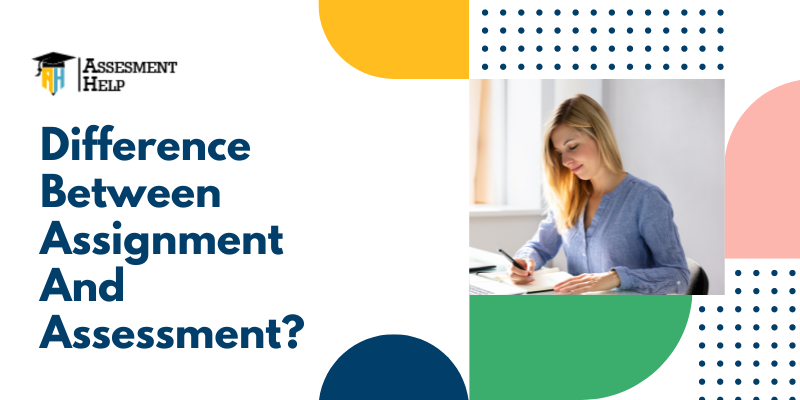
What Is The Difference Between Assignments And Assessments?
The two central ideas of contemporary education are assignment and assessment. Assignments and assessments are essential components of a student’s academic career. However, a lot of students are unaware of the fundamental distinction between an assignment and an assessment. Assignment refers to the distribution of the numerous tasks that students must do to receive the best grades in their academic curriculums. In comparison, a teacher will assess students by giving them a variety of assessment tasks that may be of different types and observing what information and skills they have learned. A student can get to know various outcomes of their learning and how they are progressing with learning objectives by completing the assessment activity.
For the best results in their academic work, students pursuing a variety of courses at various colleges must deal with assignments and assessments. Therefore, they must complete these two tasks using the right format and procedure. Assessments include writing assignments, class exercises, quizzes, case studies, and group activities, whereas assignments consist of writing tasks like case studies, reports, essays, etc. As a result, both are equally important but approached in different ways.
Let’s have a look at this in detail!
What Is An Assignment?
Assignments are pieces of writing paper or homework that a lecturer or university gives to assess your knowledge and abilities. It may also be referred to as writing assignments that must be finished and submit in before the deadlines. This is a requirement for their academic work; thus, you must conduct extensive research to finish the assignment. Numerous tasks require you to select a topic before you begin writing on it, including essays, reports, a thesis, case study assignments, and many more. It aids in the development of your comprehension and learning abilities, and you can conduct your research to finish these assignments. Additionally, it develops research and analytical skills, which will help the students in the future.
What Is An Assessment?
Assessment refers to the process by which a teacher evaluates the scholars’ knowledge and learning outcomes. In other words, multiple assessment assignments can be used to evaluate your academic development. It aids the professor in determining a student’s aptitude and degree of curricular compliance. Because of this, an assessment is an interactive process that focuses on both teaching and learning. An assignment may occasionally serve as an assessment tool.
Formative and summative assessments are the two main types of assessment. Summative evaluation takes place after each learning unit, whereas formative evaluation is undertaken throughout the learning process. Assessment includes tests, assignments, group projects, quizzes, and summaries.
What Is The Format Of An Assignment?
Understanding the right format and structure is essential before beginning any work. The format is crucial in capturing the reader’s interest. You’ll be able to compose the assignment extremely precisely if you follow the right format for an assignment. As a result, the most crucial assignment writing format must be used.
- Executive summary: The executive summary is crucial for making a good first impression on the reader; therefore, when a student begins writing an assignment, he needs to focus on it. It briefly describes an academic topic, such as a project proposal or business strategy. It provides a synopsis of the case study or reports writing and a solid structure for the writing techniques you’ll employ later on.
- Table of content: Each subsection in this section must be listed together with the relevant page number. It will surely be helpful for the reader to skip straight to the topic’s intriguing parts. Also, they can directly jump to that topic according to their interest.
- Introduction: The first section of your assignment must contain all of the crucial information related to the topic you have chosen for the assignment. In this section, you have to be very precise and clear while framing it. You need to mention all those details that you are going to explain in the further assignment. Therefore an introduction must create an impact on the reader’s mind and develop an interest in reading the whole assignment.
- Body section: After the introduction is complete, you must start on the body section. All of the crucial information should be mentioned in the assignment’s central section. When you reach this part, you need to be familiar with the major ideas, illustrations, and statistics.
- Conclusion: In conclusion, you must be able to present a summary of all the data once the primary steps have been completed. Never provide extra information for the assignment.
What Are The Major Steps To Complete An Assessment Task?
- Know the purpose of evaluation: This stage clarifies the aim of the meeting to everyone in attendance. Additionally, it establishes the meeting’s objectives and tone. It also makes it clear how questions and remarks that should be shorter for the meeting’s format will be addressed. Use our recommended introduction in the description below, or write your own.
- Determine the work provided to you: In this phase, the learner and you will review the pertinent responses you both filled out on your assessment form. The Educator should have gone over these in advance and taken any necessary notes.
- Discuss all your work and start writing it: Items for homework are tasks that must be finished at home. To allow the learner and Educator enough time to complete the work, they are assigned homework. To answer questions from the learner and to make expectations clear, homework is discussed in this stage so that you can get the best answers for your assessment questions.
If you are enrolled in a course or program offered by a reputable university, you must understand the assignment and assessment differences. Since you will be dealing with both tasks during your curriculum, it will aid you in writing them correctly. You can seek assistance from our assessment help services if you still need help understanding the difference and are unable to complete the assignment or assessment activity. Our most experienced expert will help you correctly write your assignment or assessment work. Our highly qualified experts are skilled at assessment and assignment help and finishing them before the deadlines.
- ← How To Get The Most Out Of Your Research Paper Help
- CHCPRP001 Assessment Answers →
Center for Teaching
Assessing student learning.

Forms and Purposes of Student Assessment
Assessment is more than grading, assessment plans, methods of student assessment, generative and reflective assessment, teaching guides related to student assessment, references and additional resources.
Student assessment is, arguably, the centerpiece of the teaching and learning process and therefore the subject of much discussion in the scholarship of teaching and learning. Without some method of obtaining and analyzing evidence of student learning, we can never know whether our teaching is making a difference. That is, teaching requires some process through which we can come to know whether students are developing the desired knowledge and skills, and therefore whether our instruction is effective. Learning assessment is like a magnifying glass we hold up to students’ learning to discern whether the teaching and learning process is functioning well or is in need of change.
To provide an overview of learning assessment, this teaching guide has several goals, 1) to define student learning assessment and why it is important, 2) to discuss several approaches that may help to guide and refine student assessment, 3) to address various methods of student assessment, including the test and the essay, and 4) to offer several resources for further research. In addition, you may find helfpul this five-part video series on assessment that was part of the Center for Teaching’s Online Course Design Institute.
What is student assessment and why is it Important?
In their handbook for course-based review and assessment, Martha L. A. Stassen et al. define assessment as “the systematic collection and analysis of information to improve student learning” (2001, p. 5). An intentional and thorough assessment of student learning is vital because it provides useful feedback to both instructors and students about the extent to which students are successfully meeting learning objectives. In their book Understanding by Design , Grant Wiggins and Jay McTighe offer a framework for classroom instruction — “Backward Design”— that emphasizes the critical role of assessment. For Wiggins and McTighe, assessment enables instructors to determine the metrics of measurement for student understanding of and proficiency in course goals. Assessment provides the evidence needed to document and validate that meaningful learning has occurred (2005, p. 18). Their approach “encourages teachers and curriculum planners to first ‘think like an assessor’ before designing specific units and lessons, and thus to consider up front how they will determine if students have attained the desired understandings” (Wiggins and McTighe, 2005, p. 18). [1]
Not only does effective assessment provide us with valuable information to support student growth, but it also enables critically reflective teaching. Stephen Brookfield, in Becoming a Critically Reflective Teacher, argues that critical reflection on one’s teaching is an essential part of developing as an educator and enhancing the learning experience of students (1995). Critical reflection on one’s teaching has a multitude of benefits for instructors, including the intentional and meaningful development of one’s teaching philosophy and practices. According to Brookfield, referencing higher education faculty, “A critically reflective teacher is much better placed to communicate to colleagues and students (as well as to herself) the rationale behind her practice. She works from a position of informed commitment” (Brookfield, 1995, p. 17). One important lens through which we may reflect on our teaching is our student evaluations and student learning assessments. This reflection allows educators to determine where their teaching has been effective in meeting learning goals and where it has not, allowing for improvements. Student assessment, then, both develop the rationale for pedagogical choices, and enables teachers to measure the effectiveness of their teaching.
The scholarship of teaching and learning discusses two general forms of assessment. The first, summative assessment , is one that is implemented at the end of the course of study, for example via comprehensive final exams or papers. Its primary purpose is to produce an evaluation that “sums up” student learning. Summative assessment is comprehensive in nature and is fundamentally concerned with learning outcomes. While summative assessment is often useful for communicating final evaluations of student achievement, it does so without providing opportunities for students to reflect on their progress, alter their learning, and demonstrate growth or improvement; nor does it allow instructors to modify their teaching strategies before student learning in a course has concluded (Maki, 2002).
The second form, formative assessment , involves the evaluation of student learning at intermediate points before any summative form. Its fundamental purpose is to help students during the learning process by enabling them to reflect on their challenges and growth so they may improve. By analyzing students’ performance through formative assessment and sharing the results with them, instructors help students to “understand their strengths and weaknesses and to reflect on how they need to improve over the course of their remaining studies” (Maki, 2002, p. 11). Pat Hutchings refers to as “assessment behind outcomes”: “the promise of assessment—mandated or otherwise—is improved student learning, and improvement requires attention not only to final results but also to how results occur. Assessment behind outcomes means looking more carefully at the process and conditions that lead to the learning we care about…” (Hutchings, 1992, p. 6, original emphasis). Formative assessment includes all manner of coursework with feedback, discussions between instructors and students, and end-of-unit examinations that provide an opportunity for students to identify important areas for necessary growth and development for themselves (Brown and Knight, 1994).
It is important to recognize that both summative and formative assessment indicate the purpose of assessment, not the method . Different methods of assessment (discussed below) can either be summative or formative depending on when and how the instructor implements them. Sally Brown and Peter Knight in Assessing Learners in Higher Education caution against a conflation of the method (e.g., an essay) with the goal (formative or summative): “Often the mistake is made of assuming that it is the method which is summative or formative, and not the purpose. This, we suggest, is a serious mistake because it turns the assessor’s attention away from the crucial issue of feedback” (1994, p. 17). If an instructor believes that a particular method is formative, but he or she does not take the requisite time or effort to provide extensive feedback to students, the assessment effectively functions as a summative assessment despite the instructor’s intentions (Brown and Knight, 1994). Indeed, feedback and discussion are critical factors that distinguish between formative and summative assessment; formative assessment is only as good as the feedback that accompanies it.
It is not uncommon to conflate assessment with grading, but this would be a mistake. Student assessment is more than just grading. Assessment links student performance to specific learning objectives in order to provide useful information to students and instructors about learning and teaching, respectively. Grading, on the other hand, according to Stassen et al. (2001) merely involves affixing a number or letter to an assignment, giving students only the most minimal indication of their performance relative to a set of criteria or to their peers: “Because grades don’t tell you about student performance on individual (or specific) learning goals or outcomes, they provide little information on the overall success of your course in helping students to attain the specific and distinct learning objectives of interest” (Stassen et al., 2001, p. 6). Grades are only the broadest of indicators of achievement or status, and as such do not provide very meaningful information about students’ learning of knowledge or skills, how they have developed, and what may yet improve. Unfortunately, despite the limited information grades provide students about their learning, grades do provide students with significant indicators of their status – their academic rank, their credits towards graduation, their post-graduation opportunities, their eligibility for grants and aid, etc. – which can distract students from the primary goal of assessment: learning. Indeed, shifting the focus of assessment away from grades and towards more meaningful understandings of intellectual growth can encourage students (as well as instructors and institutions) to attend to the primary goal of education.
Barbara Walvoord (2010) argues that assessment is more likely to be successful if there is a clear plan, whether one is assessing learning in a course or in an entire curriculum (see also Gelmon, Holland, and Spring, 2018). Without some intentional and careful plan, assessment can fall prey to unclear goals, vague criteria, limited communication of criteria or feedback, invalid or unreliable assessments, unfairness in student evaluations, or insufficient or even unmeasured learning. There are several steps in this planning process.
- Defining learning goals. An assessment plan usually begins with a clearly articulated set of learning goals.
- Defining assessment methods. Once goals are clear, an instructor must decide on what evidence – assignment(s) – will best reveal whether students are meeting the goals. We discuss several common methods below, but these need not be limited by anything but the learning goals and the teaching context.
- Developing the assessment. The next step would be to formulate clear formats, prompts, and performance criteria that ensure students can prepare effectively and provide valid, reliable evidence of their learning.
- Integrating assessment with other course elements. Then the remainder of the course design process can be completed. In both integrated (Fink 2013) and backward course design models (Wiggins & McTighe 2005), the primary assessment methods, once chosen, become the basis for other smaller reading and skill-building assignments as well as daily learning experiences such as lectures, discussions, and other activities that will prepare students for their best effort in the assessments.
- Communicate about the assessment. Once the course has begun, it is possible and necessary to communicate the assignment and its performance criteria to students. This communication may take many and preferably multiple forms to ensure student clarity and preparation, including assignment overviews in the syllabus, handouts with prompts and assessment criteria, rubrics with learning goals, model assignments (e.g., papers), in-class discussions, and collaborative decision-making about prompts or criteria, among others.
- Administer the assessment. Instructors then can implement the assessment at the appropriate time, collecting evidence of student learning – e.g., receiving papers or administering tests.
- Analyze the results. Analysis of the results can take various forms – from reading essays to computer-assisted test scoring – but always involves comparing student work to the performance criteria and the relevant scholarly research from the field(s).
- Communicate the results. Instructors then compose an assessment complete with areas of strength and improvement, and communicate it to students along with grades (if the assignment is graded), hopefully within a reasonable time frame. This also is the time to determine whether the assessment was valid and reliable, and if not, how to communicate this to students and adjust feedback and grades fairly. For instance, were the test or essay questions confusing, yielding invalid and unreliable assessments of student knowledge.
- Reflect and revise. Once the assessment is complete, instructors and students can develop learning plans for the remainder of the course so as to ensure improvements, and the assignment may be changed for future courses, as necessary.
Let’s see how this might work in practice through an example. An instructor in a Political Science course on American Environmental Policy may have a learning goal (among others) of students understanding the historical precursors of various environmental policies and how these both enabled and constrained the resulting legislation and its impacts on environmental conservation and health. The instructor therefore decides that the course will be organized around a series of short papers that will combine to make a thorough policy report, one that will also be the subject of student presentations and discussions in the last third of the course. Each student will write about an American environmental policy of their choice, with a first paper addressing its historical precursors, a second focused on the process of policy formation, and a third analyzing the extent of its impacts on environmental conservation or health. This will help students to meet the content knowledge goals of the course, in addition to its goals of improving students’ research, writing, and oral presentation skills. The instructor then develops the prompts, guidelines, and performance criteria that will be used to assess student skills, in addition to other course elements to best prepare them for this work – e.g., scaffolded units with quizzes, readings, lectures, debates, and other activities. Once the course has begun, the instructor communicates with the students about the learning goals, the assignments, and the criteria used to assess them, giving them the necessary context (goals, assessment plan) in the syllabus, handouts on the policy papers, rubrics with assessment criteria, model papers (if possible), and discussions with them as they need to prepare. The instructor then collects the papers at the appropriate due dates, assesses their conceptual and writing quality against the criteria and field’s scholarship, and then provides written feedback and grades in a manner that is reasonably prompt and sufficiently thorough for students to make improvements. Then the instructor can make determinations about whether the assessment method was effective and what changes might be necessary.
Assessment can vary widely from informal checks on understanding, to quizzes, to blogs, to essays, and to elaborate performance tasks such as written or audiovisual projects (Wiggins & McTighe, 2005). Below are a few common methods of assessment identified by Brown and Knight (1994) that are important to consider.
According to Euan S. Henderson, essays make two important contributions to learning and assessment: the development of skills and the cultivation of a learning style (1980). The American Association of Colleges & Universities (AAC&U) also has found that intensive writing is a “high impact” teaching practice likely to help students in their engagement, learning, and academic attainment (Kuh 2008).
Things to Keep in Mind about Essays
- Essays are a common form of writing assignment in courses and can be either a summative or formative form of assessment depending on how the instructor utilizes them.
- Essays encompass a wide array of narrative forms and lengths, from short descriptive essays to long analytical or creative ones. Shorter essays are often best suited to assess student’s understanding of threshold concepts and discrete analytical or writing skills, while longer essays afford assessments of higher order concepts and more complex learning goals, such as rigorous analysis, synthetic writing, problem solving, or creative tasks.
- A common challenge of the essay is that students can use them simply to regurgitate rather than analyze and synthesize information to make arguments. Students need performance criteria and prompts that urge them to go beyond mere memorization and comprehension, but encourage the highest levels of learning on Bloom’s Taxonomy . This may open the possibility for essay assignments that go beyond the common summary or descriptive essay on a given topic, but demand, for example, narrative or persuasive essays or more creative projects.
- Instructors commonly assume that students know how to write essays and can encounter disappointment or frustration when they discover that this is sometimes not the case. For this reason, it is important for instructors to make their expectations clear and be prepared to assist, or provide students to resources that will enhance their writing skills. Faculty may also encourage students to attend writing workshops at university writing centers, such as Vanderbilt University’s Writing Studio .
Exams and time-constrained, individual assessment
Examinations have traditionally been a gold standard of assessment, particularly in post-secondary education. Many educators prefer them because they can be highly effective, they can be standardized, they are easily integrated into disciplines with certification standards, and they are efficient to implement since they can allow for less labor-intensive feedback and grading. They can involve multiple forms of questions, be of varying lengths, and can be used to assess multiple levels of student learning. Like essays they can be summative or formative forms of assessment.
Things to Keep in Mind about Exams
- Exams typically focus on the assessment of students’ knowledge of facts, figures, and other discrete information crucial to a course. While they can involve questioning that demands students to engage in higher order demonstrations of comprehension, problem solving, analysis, synthesis, critique, and even creativity, such exams often require more time to prepare and validate.
- Exam questions can be multiple choice, true/false, or other discrete answer formats, or they can be essay or problem-solving. For more on how to write good multiple choice questions, see this guide .
- Exams can make significant demands on students’ factual knowledge and therefore can have the side-effect of encouraging cramming and surface learning. Further, when exams are offered infrequently, or when they have high stakes by virtue of their heavy weighting in course grade schemes or in student goals, they may accompany violations of academic integrity.
- In the process of designing an exam, instructors should consider the following questions. What are the learning objectives that the exam seeks to evaluate? Have students been adequately prepared to meet exam expectations? What are the skills and abilities that students need to do well on the exam? How will this exam be utilized to enhance the student learning process?
Self-Assessment
The goal of implementing self-assessment in a course is to enable students to develop their own judgment and the capacities for critical meta-cognition – to learn how to learn. In self-assessment students are expected to assess both the processes and products of their learning. While the assessment of the product is often the task of the instructor, implementing student self-assessment in the classroom ensures students evaluate their performance and the process of learning that led to it. Self-assessment thus provides a sense of student ownership of their learning and can lead to greater investment and engagement. It also enables students to develop transferable skills in other areas of learning that involve group projects and teamwork, critical thinking and problem-solving, as well as leadership roles in the teaching and learning process with their peers.
Things to Keep in Mind about Self-Assessment
- Self-assessment is not self-grading. According to Brown and Knight, “Self-assessment involves the use of evaluative processes in which judgement is involved, where self-grading is the marking of one’s own work against a set of criteria and potential outcomes provided by a third person, usually the [instructor]” (1994, p. 52). Self-assessment can involve self-grading, but instructors of record retain the final authority to determine and assign grades.
- To accurately and thoroughly self-assess, students require clear learning goals for the assignment in question, as well as rubrics that clarify different performance criteria and levels of achievement for each. These rubrics may be instructor-designed, or they may be fashioned through a collaborative dialogue with students. Rubrics need not include any grade assignation, but merely descriptive academic standards for different criteria.
- Students may not have the expertise to assess themselves thoroughly, so it is helpful to build students’ capacities for self-evaluation, and it is important that they always be supplemented with faculty assessments.
- Students may initially resist instructor attempts to involve themselves in the assessment process. This is usually due to insecurities or lack of confidence in their ability to objectively evaluate their own work, or possibly because of habituation to more passive roles in the learning process. Brown and Knight note, however, that when students are asked to evaluate their work, frequently student-determined outcomes are very similar to those of instructors, particularly when the criteria and expectations have been made explicit in advance (1994).
- Methods of self-assessment vary widely and can be as unique as the instructor or the course. Common forms of self-assessment involve written or oral reflection on a student’s own work, including portfolio, logs, instructor-student interviews, learner diaries and dialog journals, post-test reflections, and the like.
Peer Assessment
Peer assessment is a type of collaborative learning technique where students evaluate the work of their peers and, in return, have their own work evaluated as well. This dimension of assessment is significantly grounded in theoretical approaches to active learning and adult learning . Like self-assessment, peer assessment gives learners ownership of learning and focuses on the process of learning as students are able to “share with one another the experiences that they have undertaken” (Brown and Knight, 1994, p. 52). However, it also provides students with other models of performance (e.g., different styles or narrative forms of writing), as well as the opportunity to teach, which can enable greater preparation, reflection, and meta-cognitive organization.
Things to Keep in Mind about Peer Assessment
- Similar to self-assessment, students benefit from clear and specific learning goals and rubrics. Again, these may be instructor-defined or determined through collaborative dialogue.
- Also similar to self-assessment, it is important to not conflate peer assessment and peer grading, since grading authority is retained by the instructor of record.
- While student peer assessments are most often fair and accurate, they sometimes can be subject to bias. In competitive educational contexts, for example when students are graded normatively (“on a curve”), students can be biased or potentially game their peer assessments, giving their fellow students unmerited low evaluations. Conversely, in more cooperative teaching environments or in cases when they are friends with their peers, students may provide overly favorable evaluations. Also, other biases associated with identity (e.g., race, gender, or class) and personality differences can shape student assessments in unfair ways. Therefore, it is important for instructors to encourage fairness, to establish processes based on clear evidence and identifiable criteria, and to provide instructor assessments as accompaniments or correctives to peer evaluations.
- Students may not have the disciplinary expertise or assessment experience of the instructor, and therefore can issue unsophisticated judgments of their peers. Therefore, to avoid unfairness, inaccuracy, and limited comments, formative peer assessments may need to be supplemented with instructor feedback.
As Brown and Knight assert, utilizing multiple methods of assessment, including more than one assessor when possible, improves the reliability of the assessment data. It also ensures that students with diverse aptitudes and abilities can be assessed accurately and have equal opportunities to excel. However, a primary challenge to the multiple methods approach is how to weigh the scores produced by multiple methods of assessment. When particular methods produce higher range of marks than others, instructors can potentially misinterpret and mis-evaluate student learning. Ultimately, they caution that, when multiple methods produce different messages about the same student, instructors should be mindful that the methods are likely assessing different forms of achievement (Brown and Knight, 1994).
These are only a few of the many forms of assessment that one might use to evaluate and enhance student learning (see also ideas present in Brown and Knight, 1994). To this list of assessment forms and methods we may add many more that encourage students to produce anything from research papers to films, theatrical productions to travel logs, op-eds to photo essays, manifestos to short stories. The limits of what may be assigned as a form of assessment is as varied as the subjects and skills we seek to empower in our students. Vanderbilt’s Center for Teaching has an ever-expanding array of guides on creative models of assessment that are present below, so please visit them to learn more about other assessment innovations and subjects.
Whatever plan and method you use, assessment often begins with an intentional clarification of the values that drive it. While many in higher education may argue that values do not have a role in assessment, we contend that values (for example, rigor) always motivate and shape even the most objective of learning assessments. Therefore, as in other aspects of assessment planning, it is helpful to be intentional and critically reflective about what values animate your teaching and the learning assessments it requires. There are many values that may direct learning assessment, but common ones include rigor, generativity, practicability, co-creativity, and full participation (Bandy et al., 2018). What do these characteristics mean in practice?
Rigor. In the context of learning assessment, rigor means aligning our methods with the goals we have for students, principles of validity and reliability, ethics of fairness and doing no harm, critical examinations of the meaning we make from the results, and good faith efforts to improve teaching and learning. In short, rigor suggests understanding learning assessment as we would any other form of intentional, thoroughgoing, critical, and ethical inquiry.
Generativity. Learning assessments may be most effective when they create conditions for the emergence of new knowledge and practice, including student learning and skill development, as well as instructor pedagogy and teaching methods. Generativity opens up rather than closes down possibilities for discovery, reflection, growth, and transformation.
Practicability. Practicability recommends that learning assessment be grounded in the realities of the world as it is, fitting within the boundaries of both instructor’s and students’ time and labor. While this may, at times, advise a method of learning assessment that seems to conflict with the other values, we believe that assessment fails to be rigorous, generative, participatory, or co-creative if it is not feasible and manageable for instructors and students.
Full Participation. Assessments should be equally accessible to, and encouraging of, learning for all students, empowering all to thrive regardless of identity or background. This requires multiple and varied methods of assessment that are inclusive of diverse identities – racial, ethnic, national, linguistic, gendered, sexual, class, etcetera – and their varied perspectives, skills, and cultures of learning.
Co-creation. As alluded to above regarding self- and peer-assessment, co-creative approaches empower students to become subjects of, not just objects of, learning assessment. That is, learning assessments may be more effective and generative when assessment is done with, not just for or to, students. This is consistent with feminist, social, and community engagement pedagogies, in which values of co-creation encourage us to critically interrogate and break down hierarchies between knowledge producers (traditionally, instructors) and consumers (traditionally, students) (e.g., Saltmarsh, Hartley, & Clayton, 2009, p. 10; Weimer, 2013). In co-creative approaches, students’ involvement enhances the meaningfulness, engagement, motivation, and meta-cognitive reflection of assessments, yielding greater learning (Bass & Elmendorf, 2019). The principle of students being co-creators of their own education is what motivates the course design and professional development work Vanderbilt University’s Center for Teaching has organized around the Students as Producers theme.
Below is a list of other CFT teaching guides that supplement this one and may be of assistance as you consider all of the factors that shape your assessment plan.
- Active Learning
- An Introduction to Lecturing
- Beyond the Essay: Making Student Thinking Visible in the Humanities
- Bloom’s Taxonomy
- Classroom Assessment Techniques (CATs)
- Classroom Response Systems
- How People Learn
- Service-Learning and Community Engagement
- Syllabus Construction
- Teaching with Blogs
- Test-Enhanced Learning
- Assessing Student Learning (a five-part video series for the CFT’s Online Course Design Institute)
Angelo, Thomas A., and K. Patricia Cross. Classroom Assessment Techniques: A Handbook for College Teachers . 2 nd edition. San Francisco: Jossey-Bass, 1993. Print.
Bandy, Joe, Mary Price, Patti Clayton, Julia Metzker, Georgia Nigro, Sarah Stanlick, Stephani Etheridge Woodson, Anna Bartel, & Sylvia Gale. Democratically engaged assessment: Reimagining the purposes and practices of assessment in community engagement . Davis, CA: Imagining America, 2018. Web.
Bass, Randy and Heidi Elmendorf. 2019. “ Designing for Difficulty: Social Pedagogies as a Framework for Course Design .” Social Pedagogies: Teagle Foundation White Paper. Georgetown University, 2019. Web.
Brookfield, Stephen D. Becoming a Critically Reflective Teacher . San Francisco: Jossey-Bass, 1995. Print
Brown, Sally, and Peter Knight. Assessing Learners in Higher Education . 1 edition. London ;Philadelphia: Routledge, 1998. Print.
Cameron, Jeanne et al. “Assessment as Critical Praxis: A Community College Experience.” Teaching Sociology 30.4 (2002): 414–429. JSTOR . Web.
Fink, L. Dee. Creating Significant Learning Experiences: An Integrated Approach to Designing College Courses. Second Edition. San Francisco, CA: Jossey-Bass, 2013. Print.
Gibbs, Graham and Claire Simpson. “Conditions under which Assessment Supports Student Learning. Learning and Teaching in Higher Education 1 (2004): 3-31. Print.
Henderson, Euan S. “The Essay in Continuous Assessment.” Studies in Higher Education 5.2 (1980): 197–203. Taylor and Francis+NEJM . Web.
Gelmon, Sherril B., Barbara Holland, and Amy Spring. Assessing Service-Learning and Civic Engagement: Principles and Techniques. Second Edition . Stylus, 2018. Print.
Kuh, George. High-Impact Educational Practices: What They Are, Who Has Access to Them, and Why They Matter , American Association of Colleges & Universities, 2008. Web.
Maki, Peggy L. “Developing an Assessment Plan to Learn about Student Learning.” The Journal of Academic Librarianship 28.1 (2002): 8–13. ScienceDirect . Web. The Journal of Academic Librarianship. Print.
Sharkey, Stephen, and William S. Johnson. Assessing Undergraduate Learning in Sociology . ASA Teaching Resource Center, 1992. Print.
Walvoord, Barbara. Assessment Clear and Simple: A Practical Guide for Institutions, Departments, and General Education. Second Edition . San Francisco, CA: Jossey-Bass, 2010. Print.
Weimer, Maryellen. Learner-Centered Teaching: Five Key Changes to Practice. Second Edition . San Francisco, CA: Jossey-Bass, 2013. Print.
Wiggins, Grant, and Jay McTighe. Understanding By Design . 2nd Expanded edition. Alexandria,
VA: Assn. for Supervision & Curriculum Development, 2005. Print.
[1] For more on Wiggins and McTighe’s “Backward Design” model, see our teaching guide here .
Photo credit

Teaching Guides
- Online Course Development Resources
- Principles & Frameworks
- Pedagogies & Strategies
- Reflecting & Assessing
- Challenges & Opportunities
- Populations & Contexts
Quick Links
- Services for Departments and Schools
- Examples of Online Instructional Modules
- 1300 364 499
- [email protected]

The Difference Between an Assessment and an Assignment
Posted 4 jun '20.
.jpg)
Every school has a unique method of setting work, tasks and assessing the level their students are at, but mostly these tests come in the forms of an assessment or an assignment. However, the difference between the two of these can be hard to spot - both receive task sheets, both can usually be worked on at home, they can contain some of the same content. So, how do we tell the difference and how can this help your child?
The Assignment
So, your child has come home brandishing an assignment task sheet. What does this mean exactly? An assignment is all in the name; it is the act of assigning. It is an allocation of a task or set of tasks that are marked and graded for the report card (but does not have to be). The purpose of an assignment is to give your child a more comprehensive understanding of the topic being studied and can include questions, long-form writing tasks or a more tactile and interactive activity. An assignment is usually completed at home and submitted to the school after a certain period.
The Assessment
An assessment may not come in a much different form to the assignment, but they are usually considered more important. This is because an assessment is the act of assessing the progress of your child. The assessment may be a take-home task, an exam/test, speech or something more hands-on. An assessment can be both in-class or at home. Usually, your child will get an assessment notification that is given approximately 2 weeks before the assessment is due. Particularly for Year 12s, assessments are incredibly important as they contribute to their overall internal mark.
Why It Is Important To Know The Difference
With this information, you are now able to help your child prioritise their work. Although the tasks given can look similar, knowing the weighted importance of both can help you help them to plan out when they will complete these tasks.
If you or your child require further assistance in completing schoolwork, visit www.fsedu.com.au where you can be provided personalised, one-on-one education with an experienced, dedicated teacher with an in-depth understanding of the Australian curriculum.
Written by Ben Maher - Founder and Director of Education at Full Spectrum Education
Related Articles

Blackhawks Ice Hockey Club
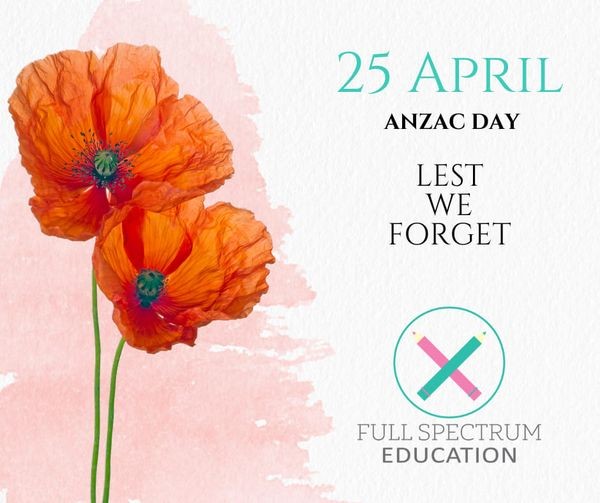
Lest we forget. 🌹


Assignment vs. Assessment — What's the Difference?
Difference Between Assignment and Assessment
Table of contents, key differences, comparison chart, action vs. judgment, individual vs. group, compare with definitions, common curiosities, is every assignment followed by an assessment, what's the purpose of an assignment, how do teachers benefit from assessments, can an assignment be collaborative, what forms can assessments take, are assignments exclusive to academic settings, what is an assignment in an educational context, how does assessment differ from grading, can assessments be biased, is feedback essential after an assessment, can one forgo an assignment, do all assignments need a deadline, why are assessments integral in the learning process, how do assignments and assessments relate to real-world skills, can an assignment be both written and oral, share your discovery.
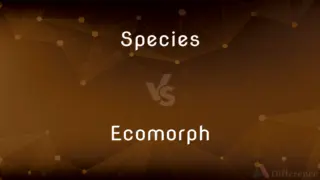
Author Spotlight
Popular Comparisons

Trending Comparisons

New Comparisons

Trending Terms


Assignments & Tests
- Ideas for Assignments
- Assessment vs. Evaluation
- Best Practices for Tests
- Tests and Academic Integrity
- Tutorials for Canvas Tests
- Tutorials for Canvas Assignments
Many people use the terms assessment and evaluation interchangeably, partly because they are both concerned with measuring success. To differentiate between them, consider this:
- Assessment relates to learners.
- Evaluation relates to the learning process.
An assessment will typically fulfill one of two general purposes. Formative assessments are designed to help you receive and give feedback that will promote further student learning. Summative assessments allow students to demonstrate their achievement of the learning objectives. The following table further highlights the differences.
Evaluation involves judgment, such as when students complete a course evaluation or an accreditation team evaluates an academic program. The purpose is to ascertain effectiveness and inform possible improvements.
Center for Instructional Design and Technology • [email protected] • 208.467.8034 • Learning Commons 146
- << Previous: Ideas for Assignments
- Next: Best Practices for Tests >>
- Last Updated: Jan 13, 2023 4:43 PM
- URL: https://library.nnu.edu/tests

- school Campus Bookshelves
- menu_book Bookshelves
- perm_media Learning Objects
- login Login
- how_to_reg Request Instructor Account
- hub Instructor Commons
- Download Page (PDF)
- Download Full Book (PDF)
- Periodic Table
- Physics Constants
- Scientific Calculator
- Reference & Cite
- Tools expand_more
- Readability
selected template will load here
This action is not available.

4.3: Types of Assignments
- Last updated
- Save as PDF
- Page ID 133160

- Ana Stevenson
- James Cook University via James Cook University

Introduction
As discussed in the previous chapter, assignments are a common method of assessment at university. You may encounter many assignments over your years of study, yet some will look quite different from others. By recognising different types of assignments and understanding the purpose of the task, you can direct your writing skills effectively to meet task requirements. This chapter draws on the skills from the previous chapter, and extends the discussion, showing you where to aim with different types of assignments.
The chapter begins by exploring the popular essay assignment, with its two common categories, analytical and argumentative essays. It then examines assignments requiring case study responses , as often encountered in fields such as health or business. This is followed by a discussion of assignments seeking a report (such as a scientific report) and reflective writing assignments, which are common in nursing, education, and human services. The chapter concludes with an examination of annotated bibliographies and literature reviews. The chapter also has a selection of templates and examples throughout to enhance your understanding and improve the efficacy of your assignment writing skills.
Different Types of Written Assignments
At university, an essay is a common form of assessment. In the previous chapter Writing Assignments, we discussed what was meant by showing academic writing in your assignments. It is important that you consider these aspects of structure, tone, and language when writing an essay.
Components of an essay
Essays should use formal but reader-friendly language and have a clear and logical structure. They must include research from credible academic sources such as peer reviewed journal articles and textbooks. This research should be referenced throughout your essay to support your ideas (see the chapter Working with Information).
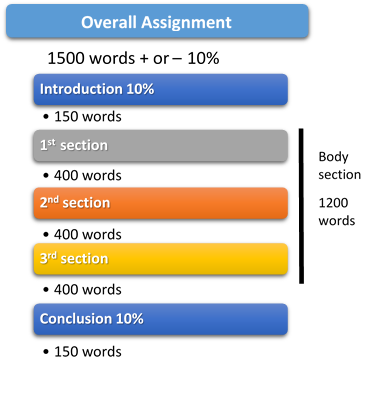
If you have never written an essay before, you may feel unsure about how to start. Breaking your essay into sections and allocating words accordingly will make this process more manageable and will make planning the overall essay structure much easier.
- An essay requires an introduction, body paragraphs, and a conclusion.
- Generally, an introduction and conclusion are each approximately 10% of the total word count.
- The remaining words can then be divided into sections and a paragraph allowed for each area of content you need to cover.
- Use your task and criteria sheet to decide what content needs to be in your plan
An effective essay introduction needs to inform your reader by doing four basic things:
An effective essay body paragraph needs to:
An effective essay conclusion needs to:
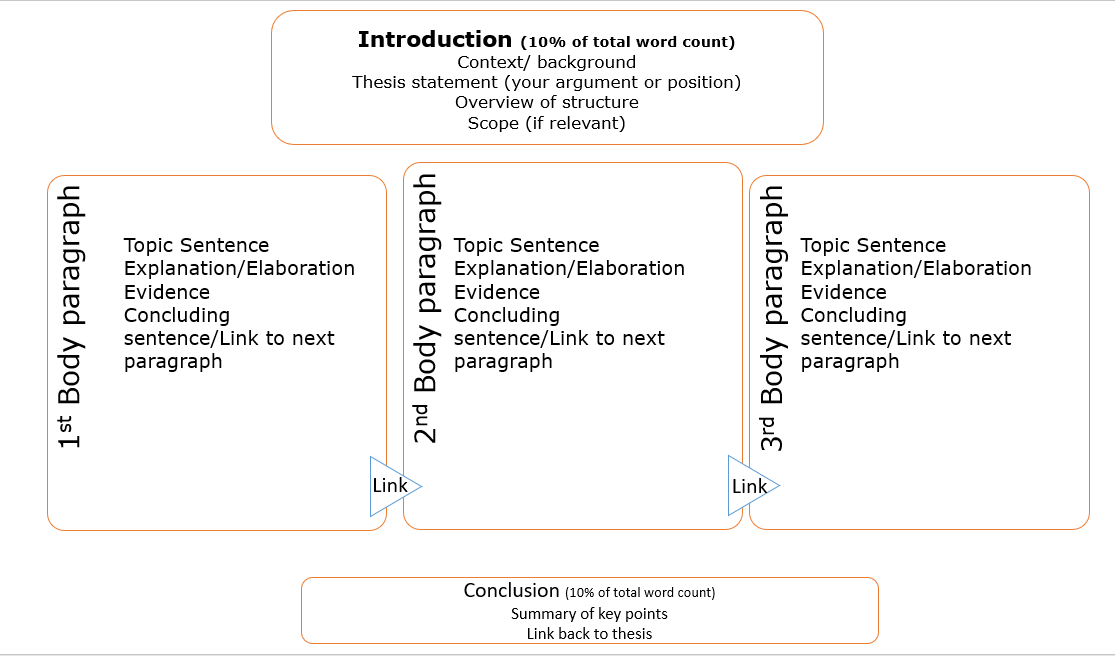
Common types of essays
You may be required to write different types of essays, depending on your study area and topic. Two of the most commonly used essays are analytical and argumentative . The task analysis process discussed in the previous chapter Writing Assignments will help you determine the type of essay required. For example, if your assignment question uses task words such as analyse, examine, discuss, determine, or explore, then you would be writing an analytical essay . If your assignment question has task words such as argue, evaluate, justify, or assess, then you would be writing an argumentative essay . Regardless of the type of essay, your ability to analyse and think critically is important and common across genres.
Analytical essays
These essays usually provide some background description of the relevant theory, situation, problem, case, image, etcetera that is your topic. Being analytical requires you to look carefully at various components or sections of your topic in a methodical and logical way to create understanding.
The purpose of the analytical essay is to demonstrate your ability to examine the topic thoroughly. This requires you to go deeper than description by considering different sides of the situation, comparing and contrasting a variety of theories and the positives and negatives of the topic. Although your position on the topic may be clear in an analytical essay, it is not necessarily a requirement that you explicitly identify this with a thesis statement. In an argumentative essay, however, it is necessary that you explicitly identify your position on the topic with a thesis statement. If you are unsure whether you are required to take a position, and provide a thesis statement, it is best to check with your tutor.
Argumentative essays
These essays require you to take a position on the assignment topic. This is expressed through your thesis statement in your introduction. You must then present and develop your arguments throughout the body of your assignment using logically structured paragraphs. Each of these paragraphs needs a topic sentence that relates to the thesis statement. In an argumentative essay, you must reach a conclusion based on the evidence you have presented.

Case study responses
Case studies are a common form of assignment in many study areas and students can underperform in this genre for a number of key reasons.
Students typically lose marks for not:
- Relating their answer sufficiently to the case details.
- Applying critical thinking.
- Writing with clear structure.
- Using appropriate or sufficient sources.
- Using accurate referencing.
When structuring your response to a case study, remember to refer to the case. Structure your paragraphs similarly to an essay paragraph structure, but include examples and data from the case as additional evidence to support your points (see Figure 68). The colours in the sample paragraph below show the function of each component.
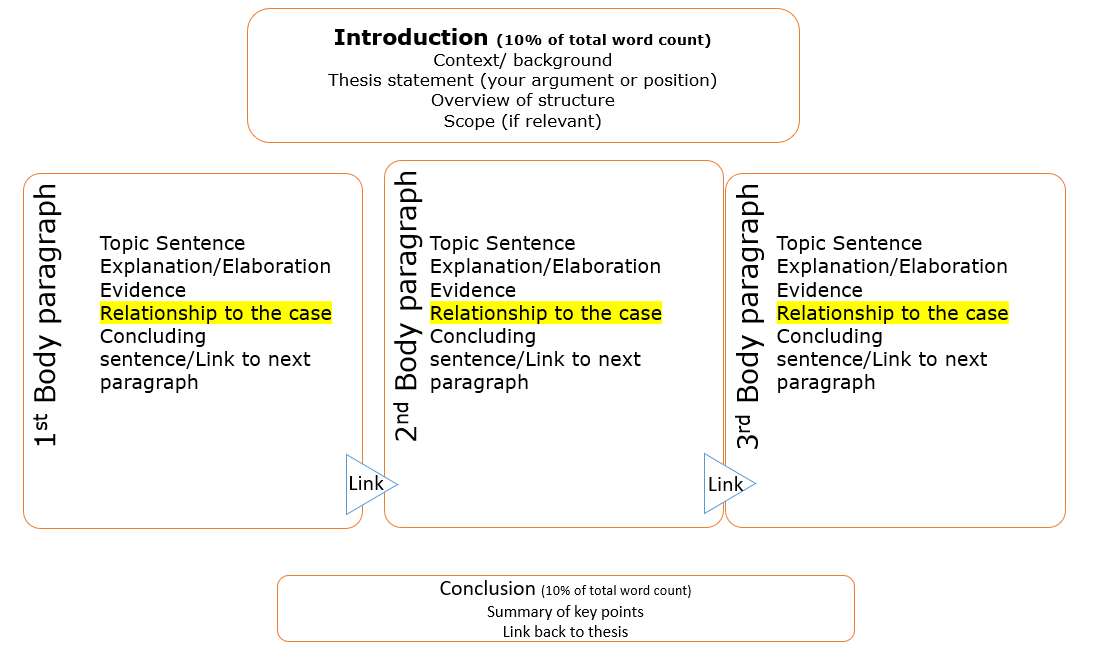
The Nursing and Midwifery Board of Australia (NMBA) Code of Conduct and Nursing Standards (2018) play a crucial role in determining the scope of practice for nurses and midwives. A key component discussed in the code is the provision of person-centred care and the formation of therapeutic relationships between nurses and patients (NMBA, 2018). This ensures patient safety and promotes health and wellbeing (NMBA, 2018). The standards also discuss the importance of partnership and shared decision-making in the delivery of care (NMBA, 2018, 4). Boyd and Dare (2014) argue that good communication skills are vital for building therapeutic relationships and trust between patients and care givers. This will help ensure the patient is treated with dignity and respect and improve their overall hospital experience. In the case, the therapeutic relationship with the client has been compromised in several ways. Firstly, the nurse did not conform adequately to the guidelines for seeking informed consent before performing the examination as outlined in principle 2.3 (NMBA, 2018). Although she explained the procedure, she failed to give the patient appropriate choices regarding her health care.
Topic sentence | Explanations using paraphrased evidence including in-text references | Critical thinking (asks the so what? question to demonstrate your student voice). | Relating the theory back to the specifics of the case. The case becomes a source of examples as extra evidence to support the points you are making.
Reports are a common form of assessment at university and are also used widely in many professions. It is a common form of writing in business, government, scientific, and technical occupations.
Reports can take many different structures. A report is normally written to present information in a structured manner, which may include explaining laboratory experiments, technical information, or a business case. Reports may be written for different audiences, including clients, your manager, technical staff, or senior leadership within an organisation. The structure of reports can vary, and it is important to consider what format is required. The choice of structure will depend upon professional requirements and the ultimate aims of the report. Consider some of the options in the table below (see Table 18.2).
Reflective writing
Reflective writing is a popular method of assessment at university. It is used to help you explore feelings, experiences, opinions, events, or new information to gain a clearer and deeper understanding of your learning.

A reflective writing task requires more than a description or summary. It requires you to analyse a situation, problem or experience, consider what you may have learnt, and evaluate how this may impact your thinking and actions in the future. This requires critical thinking, analysis, and usually the application of good quality research, to demonstrate your understanding or learning from a situation.
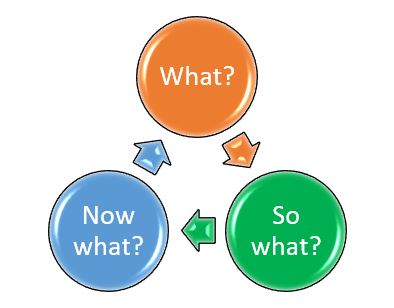
Essentially, reflective practice is the process of looking back on past experiences and engaging with them in a thoughtful way and drawing conclusions to inform future experiences. The reflection skills you develop at university will be vital in the workplace to assist you to use feedback for growth and continuous improvement. There are numerous models of reflective writing and you should refer to your subject guidelines for your expected format. If there is no specific framework, a simple model to help frame your thinking is What? So what? Now what? (Rolfe et al., 2001).
The Gibbs’ Reflective Cycle
The Gibbs’ Cycle of reflection encourages you to consider your feelings as part of the reflective process. There are six specific steps to work through. Following this model carefully and being clear of the requirements of each stage, will help you focus your thinking and reflect more deeply. This model is popular in Health.
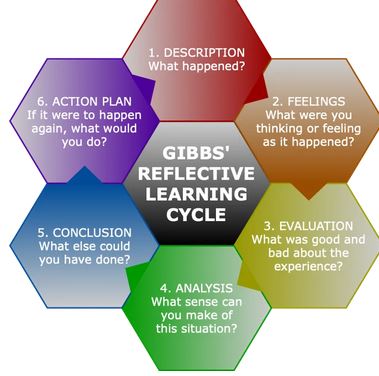
The 4 R’s of reflective thinking
This model (Ryan and Ryan, 2013) was designed specifically for university students engaged in experiential learning. Experiential learning includes any ‘real-world’ activities, including practice led activities, placements, and internships. Experiential learning, and the use of reflective practice to heighten this learning, is common in Creative Arts, Health, and Education.
Annotated bibliography
What is it.
An annotated bibliography is an alphabetical list of appropriate sources (e.g. books, journal articles, or websites) on a topic, accompanied by a brief summary, evaluation, and sometimes an explanation or reflection on their usefulness or relevance to your topic. Its purpose is to teach you to research carefully, evaluate sources and systematically organise your notes. An annotated bibliography may be one part of a larger assessment item or a stand-alone assessment item. Check your task guidelines for the number of sources you are required to annotate and the word limit for each entry.
How do I know what to include?
When choosing sources for your annotated bibliography, it is important to determine:
- The topic you are investigating and if there is a specific question to answer.
- The type of sources on which you need to focus.
- Whether these sources are reputable and of high quality.
What do I say?
Important considerations include:
- Is the work current?
- Is the work relevant to your topic?
- Is the author credible/reliable?
- Is there any author bias?
- The strength and limitations (this may include an evaluation of research methodology).
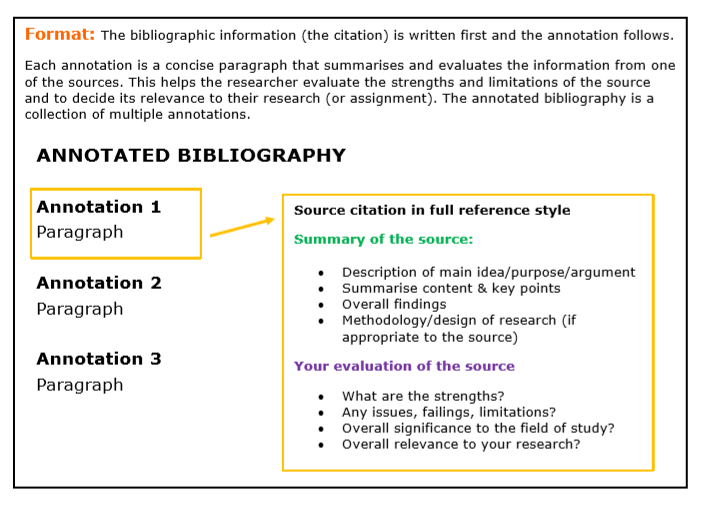
Literature reviews
Generally, a literature review requires that you review the scholarly literature and establish the main ideas that have been written about your chosen topic. A literature review does not summarise and evaluate each resource you find (this is what you would do in an annotated bibliography). You are expected to analyse and synthesise or organise common ideas from multiple texts into key themes which are relevant to your topic (see Figure 18.10). You may also be expected to identify gaps in the research.
It is easy to get confused by the terminology used for literature reviews. Some tasks may be described as a systematic literature review when actually the requirement is simpler; to review the literature on the topic but do it in a systematic way. There is a distinct difference (see Table 15.4). As a commencing undergraduate student, it is unlikely you would be expected to complete a systematic literature review as this is a complex and more advanced research task. It is important to check with your lecturer or tutor if you are unsure of the requirements.
When conducting a literature review, use a table or a spreadsheet, if you know how, to organise the information you find. Record the full reference details of the sources as this will save you time later when compiling your reference list (see Table 18.5).
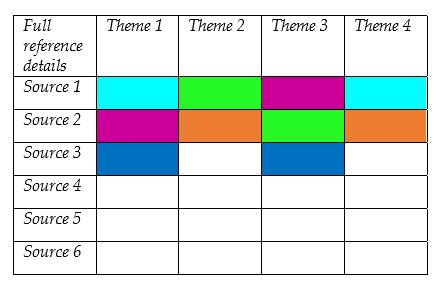
Overall, this chapter has provided an introduction to the types of assignments you can expect to complete at university, as well as outlined some tips and strategies with examples and templates for completing them. First, the chapter investigated essay assignments, including analytical and argumentative essays. It then examined case study assignments, followed by a discussion of the report format. Reflective writing , popular in nursing, education, and human services, was also considered. Finally, the chapter briefly addressed annotated bibliographies and literature reviews. The chapter also has a selection of templates and examples throughout to enhance your understanding and improve the efficacy of your assignment writing skills.
- Not all assignments at university are the same. Understanding the requirements of different types of assignments will assist in meeting the criteria more effectively.
- There are many different types of assignments. Most will require an introduction, body paragraphs, and a conclusion.
- An essay should have a clear and logical structure and use formal but reader-friendly language.
- Breaking your assignment into manageable chunks makes it easier to approach.
- Effective body paragraphs contain a topic sentence.
- A case study structure is similar to an essay, but you must remember to provide examples from the case or scenario to demonstrate your points.
- The type of report you may be required to write will depend on its purpose and audience. A report requires structured writing and uses headings.
- Reflective writing is popular in many disciplines and is used to explore feelings, experiences, opinions, or events to discover what learning or understanding has occurred. Reflective writing requires more than description. You need to be analytical, consider what has been learnt, and evaluate the impact of this on future actions.
- Annotated bibliographies teach you to research and evaluate sources and systematically organise your notes. They may be part of a larger assignment.
- Literature reviews require you to look across the literature and analyse and synthesise the information you find into themes.
Gibbs, G. (1988). Learning by doing: A guide to teaching and learning methods. Further Education Unit, Oxford Brookes University.
Rolfe, G., Freshwater, D., Jasper, M. (2001). Critical reflection in nursing and the helping professions: A user’s guide . Palgrave Macmillan.
Ryan, M. & Ryan, M. (2013). Theorising a model for teaching and assessing reflective learning in higher education. Higher Education Research & Development , 32(2), 244-257. https://doi.org/10.1080/07294360.2012.661704

- Digital Teaching and Learning Tools
- Assessment and Feedback Tools
Assessment Criteria and Rubrics
An introduction.
This guide is an introduction to:
- Writing an assessment brief with clear assessment criteria and rubrics
- Grading tools available in Turnitin enabling the use of criteria and rubrics in marking.
Clear and explicit assessment criteria and rubrics are meant to increase the transparency of the assessment and aim to develop students into ‘novice assessors’ (Gipps, 1994) and facilitating deep learning. Providing well-designed criteria and rubrics, contributes to communicating assessment requirements that can be more inclusive to all (including markers) regardless of previous learning experiences, and or individual differences in language, cultural and educational background. It also facilitates the development of self-judgment skills (Boud & Falchikov, 2007).
- Assessment brief
- Assessment criteria
- Assessment rubric
- Guidance in how to create rubrics and grading forms
- Guidance on how to create a rubric in Handin
Terminology Explored
The terms ‘assessment brief’ , ‘assessment criteria’ and ‘assessment rubrics’ however, are often used interchangeably and that may lead to misunderstandings and impact on the effectiveness of the design and interpretation of the assessment brief. Therefore, it is important to first clarify these terms:
Assessment Brief
An assessment (assignment) brief refers to the instructions provided to communicate the requirements and expectations of assessment tasks, including the assessment criteria and rubrics to students. The brief should clearly outline which module learning outcomes will assessed in the assignment.
NOTE: If you are new to writing learning outcomes, or need a refresher, have a look at Baume’s guide to “Writing and using good learning outcomes”, (2009). See list of references.
When writing an assessment brief, it may be useful to consider the following questions with regards to your assessment brief:
- Have you outlined clearly what type of assessment you require students to complete? For example, instead of “written assessment”, outline clearly what type of written assessment you require from your students; is it a report, a reflective journal, a blog, presentation, etc. It is also recommended to give a breakdown of the individual tasks that make up the full assessment within the brief, to ensure transparency.
- Is the purpose of the assessment immediately clear to your students, i.e. why the student is being asked to do the task? It might seem obvious to you as an academic, but for students new to academia and the subject discipline, it might not be clear. For example, explain why they have to write a reflective report or a journal and indicate which module learning outcomes are to be assessed in this specific assessment task.
- Is all the important task information clearly outlined, such as assessment deadlines, word count, criteria and further support and guidance?
Assessment Criteria
Assessment criteria communicate to students the knowledge, skills and understanding (thus in line with the expected module learning outcomes) the assessors expect from students to evidence in any given assessment task. To write a good set of criteria, the focus should be on the characteristics of the learning outcomes that the assignment will evidence and not only consider the characteristics of the assignment (task), i.e., presentation, written task, etc.
Thus, the criteria outlines what we expect from our students (based on learning outcomes), however it does not in itself make assumptions about the actual quality or level of achievement (Sadler, 1987: 194) and needs to be refined in the assessment rubric.
When writing an assessment brief, it may be useful to consider the following questions with regards to the criteria that will be applied to assess the assignment:
- Are your criteria related and aligned with the module and (or) the course learning outcomes?
- What are the number of criteria you will assess in any particular task? Consider how realistic and achievable this may be.
- Are the criteria clear and have you avoided using any terms not clear to students (academic jargon)?
- Are the criteria and standards (your quality definitions) aligned with the level of the course? For guidance, consider revisiting the Credit Level Descriptors (SEEC, 2016) and the QAA Subject Benchmarks in Framework for the Higher Education Qualifications that are useful starting points to consider.
Assessment Rubric
The assessment rubric, forms part of a set of criteria and refers specifically to the “levels of performance quality on the criteria.” (Brookhart & Chen, 2015, p. 343)
Generally, rubrics are categorised into two categories, holistic and or analytic. A holistic rubric assesses an assignment as a whole and is not broken down into individual assessment criteria. For the purpose of this guidance, the focus will be on an analytic rubric that provides separate performance descriptions for each criterion.
An assessment rubric is therefore a tool used in the process of assessing student work that usually includes essential features namely the:
- Scoring strategy – Can be numerical of qualitative, associated with the levels of mastery (quality definitions). (Shown as SCALE in Turnitin)
- Quality definitions (levels of mastery) – Specify the levels of achievement / performance in each criterion.
(Dawson, 2017).
The figure below, is an example of the features of a complete rubric including the assessment criteria.
When writing an assessment brief, it may be useful to consider the following questions with regards to firstly, the assessment brief, and secondly, the criteria and associated rubrics.
- Does your scoring strategy clearly define and cover the whole grading range? For example, do you distinguish between the distinctions (70-79%) and 80% and above?
- Are the words and terms used to indicate level of mastery, clearly outlining and enabling students to distinguish between the different judgements? For example, how do you differentiate between work that is outstanding, excellent and good?
- Is the chosen wording in your rubric too explicit? It should be explicit but at the same time not overly specific to avoid students adopting a mechanistic approach to your assignment. For example, instead of stating a minimum number references, consider stating rather effectiveness or quality of the use of literature, and or awareness or critical analysis of supporting literature.
NOTE: For guidance across Coventry University Group on writing criteria and rubrics, follow the links to guidance.
POST GRADUATE Assessment criteria and rubrics (mode R)
UNDER GRADUATE Assessment criteria and rubrics (mode E)
Developing Criteria and Rubrics within Turnitin
Within Turnitin, depending on the type of assessment, you have a choice between four grading tools:
- Qualitative Rubric – A rubric that provides feedback but has no numeric scoring. More descriptive than measurable. This rubric is selected by choosing the ‘0’ symbol at the base of the Rubric.
- Standard Rubric – Used for numeric scoring. Enter scale values for each column (rubric score) and percentages for each criteria row, combined to be equal to 100%. This rubric can calculate and input the overall grade. This rubric is selected by choosing the % symbol at the base of the Rubric window.
- Custom Rubric – Add criteria (row) and descriptive scales (rubric), when marking enter (type) any value directly into each rubric cell. This rubric will calculate and input the overall grade. This rubric is selected by choosing the ‘Pencil’ symbol at the base of the Rubric window.
- Grading form – Can be used with or without numerical score. If used without numerical score, then it is more descriptive feedback. If used with numerical scoring, this can be added together to create an overall grade. Note that grading forms can be used without a ‘paper assignment’ being submitted, for example, they can be used to assess work such as video submission, work of art, computer programme or musical performance.
Guidance on how to Create Rubric and Grading Forms
Guidance by Turnitin:
https://help.turnitin.com/feedback-studio/turnitin-website/instructor/rubric-scorecards-and-grading-forms/creating-a-rubric-or-grading-form-during-assignment-creation.htm
University of Kent – Creating and using rubrics and grading form (written guidance):
https://www.kent.ac.uk/elearning/files/turnitin/turnitin-rubrics.pdf
Some Examples to Explore
It is useful to explore some examples in Higher Education, and the resource developed by UCL of designing generic assessment criteria and rubrics from level 4 to 7, is a good starting point.
Guidance on how to Create Rubric in Handin
Within Handin, depending on the type of assessment, you have a choice between three grading tools, see list below, as well as the choice to use “free-form” grading that allows you to enter anything in the grade field when grading submissions.
- None = qualitative
- Range = quantitative – can choose score from range
- Fixed = quantitative – one score per level
Guide to Handin: Creating ungraded (“free-form”) assignments
https://aula.zendesk.com/hc/en-us/articles/360053926834
Guide to Handin: Creating rubrics https://aula.zendesk.com/hc/en-us/articles/360017154820-How-can-I-use-Rubrics-for-Assignments-in-Aula-
References and Further Reading
Baume, D (2009) Writing and using good learning outcomes. Leeds Metropolitan University. ISBN 978-0-9560099-5-1 Link to Leeds Beckett Repository record: http://eprints.leedsbeckett.ac.uk/id/eprint/2837/1/Learning_Outcomes.pdf
Boud, D & Falchikov, N. (2007) Rethinking Assessment in Higher Education. London: Routledge.
Brookhart, S.M. & Chen, F. (2015) The quality and effectiveness of descriptive rubrics, Educational Review, 67:3, pp.343-368. http://dx.doi.org/10.1080/00131911.2014.929565
Dawson, P. (2017) Assessment rubrics: Towards clearer and more replicable design, research and practice. Assessment & Evaluation in Higher Education, 42(3), pp.347-360. https://doi.org/10.1080/02602938.2015.1111294
Gipps, C.V. (1994) Beyond testing: Towards a theory of educational assessment. Psychology Press.
Sadler, D.R. (1987) Specifying and promulgating achievement standards. Oxford Review of Education, 13(2), pp.191-209.
SEEC (2016) Credit Level Descriptors. Available: http://www.seec.org.uk/wp-content/uploads/2016/07/SEEC-descriptors-2016.pdf
UK QAA Quality Code (2014) Part A – Setting and Maintaining Academic Standards. Available: https://www.qaa.ac.uk/docs/qaa/quality-code/qualifications-frameworks.pdf
Was this article helpful?
All Categories > Assessments > What is the difference between an Assessment and an Assignment?
What is the difference between an Assessment and an Assignment?

How did we do?
Assignments vs Assessments: When to Use Them

- Discussions
- Announcements

Blackbaud's Academics product offers educators plenty of ways to create new work for students. However, it may not always be clear which option is best suited to accomplish what you need. Let's talk about Assignments versus Assessments.
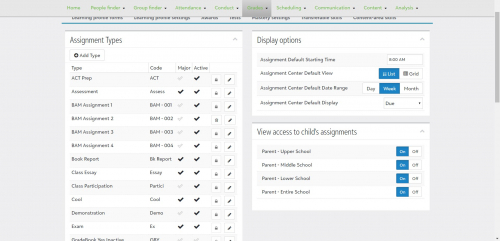
Leave a Comment
- Privacy Policy
- Privacy Shield Notice
- Terms of Use
- Acceptable Use Policy
- General Data Protection Regulations
- Blackbaud Customer Support
- Knowledgebase
- © 2024 Blackbaud
- Powered by Personify Community

Difference between Assignment and Assessment
What is the difference between assignment and assessment.
Assignment as a noun is the act of assigning, or an assigned task while Assessment as a noun is the act of assessing or an amount (of tax, levy or duty etc) assessed.
Part of speech: noun
Definition: the act of assigning, or an assigned task a position to which someone is assigned a task given to students, homework or coursework a transfer of something from one person to another, especially property, or a claim or right; the document that effects this transfer an operation that assigns a value to a variable
Definition: The act of assessing or an amount (of tax, levy or duty etc) assessed. An appraisal or evaluation.
We hope you now know whether to use Assignment or Assessment in your sentence.
enfolding vs involution
Difference between profit and gain, conformation and conformity - what's the difference, relief vs relieve, hothead and fire-eater - what's the difference, agreeance vs agreement, slave and sissy - what's the difference, lengthening and prolongation - what's the difference, popular articles, difference between level 1, level 2 and level 3 electric car chargers, difference between disney+ hotstar(indian version) and disney+ international version, the fascination with vinyl: vinyl vs. cd vs. streaming services, reading on an ipad vs reading on a kindle.
People often get confused between similar sounding words or synonyms. Most of the time these words have slightly different meanings, and some time entirely different meanings. We help people discover the difference between these words.
- Key Differences
Know the Differences & Comparisons
Difference Between Assessment and Evaluation
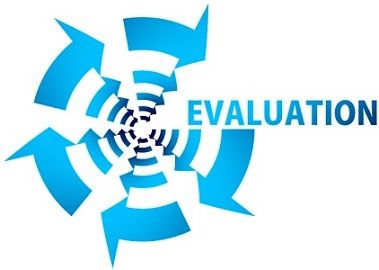
The basic difference between assessment and evaluation lies in the orientation, i.e. while the assessment is process oriented, evaluation is product oriented. The article presented to you describes all the distinguishing points between these two.
Content: Assessment Vs Evaluation
Comparison chart, definition of assessment.
Assessment is defined as a methodical way of acquiring, reviewing and using information about someone or something, so as to make improvement where necessary. The term is interpreted in a variety of ways, i.e. educational, psychological, financial, taxation, human resource and so on.
In general, assessment is an ongoing interactive process, in which two parties (assessor and assessee) are involved. The assessor is someone who assesses the performance based on the defined standards, while assessee is someone who is being assessed. The process aims at determining the effectiveness of the overall performance of the assessee and the areas of improvement. The process involves, setting up goals, collecting information (qualitative and quantitative) and using the information for increasing quality.
Definition of Evaluation
The term ‘evaluation’ is derived from the word ‘value’ which refers to ‘usefulness of something’. Therefore, evaluation is an examination of something to measure its utility.
Simply put, evaluation is a systematic and objective process of measuring or observing someone or something, with an aim of drawing conclusions, using criteria, usually governed by set standards or by making a comparison. It gauges the performance of a person, completed project, process or product, to determine its worth or significance.
The evaluation includes both quantitative and qualitative analysis of data and undertaken once in a while. It ascertains whether the standards or goals established are met or not. If they are met successfully, then it identifies the difference between actual and intended outcomes.
Key Differences Between Assessment and Evaluation
The significant differences between assessment and evaluation are discussed in the points given below:
- The process of collecting, reviewing and using data, for the purpose of improvement in the current performance, is called assessment. A process of passing judgment, on the basis of defined criteria and evidence is called evaluation.
- Assessment is diagnostic in nature as it tends to identify areas of improvement. On the other hand, evaluation is judgemental, because it aims at providing an overall grade.
- The assessment provides feedback on performance and ways to enhance performance in future. As against this, evaluation ascertains whether the standards are met or not.
- The purpose of assessment is formative, i.e. to increase quality whereas evaluation is all about judging quality, therefore the purpose is summative.
- Assessment is concerned with process, while evaluation focuses on product.
- In an assessment, the feedback is based on observation and positive & negative points. In contrast to evaluation, in which the feedback relies on the level of quality as per set standard.
- In an assessment, the relationship between assessor and assessee is reflective, i.e. the criteria are defined internally. On the contrary, the evaluator and evaluatee share a prescriptive relationship, wherein the standards are imposed externally.
- The criteria for assessment are set by both the parties jointly. As opposed to evaluation, wherein the criteria are set by the evaluator.
- The measurement standards for assessment are absolute, which seeks to achieve the quintessential outcome. As against this, standards of measurement for evaluation are comparative, that makes a distinction between better and worse.
So, after reviewing the points above, it would be clear that assessment and evaluation are completely different. While evaluation involves making judgments, assessment is concerned with correcting the deficiencies in one’s performance. Although, they play a crucial role in analysing and refining the performance of a person, product, project or process.
You Might Also Like:

October 28, 2016 at 1:55 am
Thanks for sharing
Narendra says
January 29, 2017 at 6:23 am
Precise and useful.
Musaed says
October 9, 2017 at 10:00 pm
I would never be confused again about the difference between assessment and evaluation. Thanks.
Kelly Mokashi says
June 14, 2018 at 8:58 pm
Can we use this article educationally, is there a copyright issue?
Surbhi S says
June 15, 2018 at 9:40 am
You can use the article, subject to proper references are given to keydifferences.com
Naijil George says
June 19, 2018 at 6:56 pm
I thought, both are very much same. This article is an eye opener.
Mehr.a.zadeh says
July 11, 2018 at 10:39 pm
Hi, your contents are excellent. Thanx
mohammed says
August 27, 2018 at 11:34 am
very detail message with concise note
Mfanelo Siziba says
September 3, 2018 at 3:56 pm
This is wonderful, well researched. Where can I get more references on this?
September 6, 2018 at 11:14 pm
Really great summary; however, I’d appreciate it if you could add some book references.
Maryam Talebi says
December 12, 2018 at 12:22 am
I really appreciate it
Augustine B says
April 10, 2019 at 11:55 am
Thanks very much for the information which is precise and helpful.
MUGABI S.R says
September 16, 2019 at 3:37 pm
Thank you very much,I now get the difference
March 13, 2020 at 9:52 am
Thanks for the piece. Could you please distinguish the three? (measurement, assessment and evaluation)
NIMUSIIMA IVAN says
September 21, 2019 at 8:14 pm
Wonderful!! Am humbled
zulfiaqar Ali says
February 18, 2020 at 10:43 am
Thank you so much for this valuable information
May 26, 2020 at 5:11 am
thanks for help
February 12, 2021 at 5:18 am
Thanks so much for the important message and I think that it will be helpful in doing my second assignment… Cheers…
February 19, 2021 at 10:54 am
Wonderful answer
Paul King Ayinde says
February 19, 2021 at 8:49 pm
Thank you immensely for these explicit explanations. They have really helped me.
saliha belhacene says
February 20, 2021 at 1:18 am
It’s so useful. Thanks
Mansharam says
February 21, 2021 at 10:58 pm
It is a base of understanding the difference between them
Lubega paul says
March 3, 2021 at 4:08 pm
Thanks for the wonderful and precise information I have learnt a lot from your information
Munyope Joseph says
March 17, 2021 at 3:48 pm
Yes maximum appreciation for the wonderful message indeed I have learnt the distinction between these two concepts.
Nakasumba GORRET says
March 26, 2021 at 6:50 am
I thought these words are the same but l realized that there is a big difference between them thanks alot
Ainomugisha Emily says
March 28, 2021 at 11:44 am
Really helpful
Faith hajara Barack says
April 2, 2021 at 10:38 pm
Thanks a lot for the clarification
Kakaire Joseph says
April 8, 2021 at 12:27 pm
Thanks for the message have really learnt about assessment and evaluation and their comparisons
Agaba Ashraf says
April 9, 2021 at 3:03 am
Thanx i have managed to understand and learnt how to distinguish between evaluation and assessment and they cannot confuse me at all in applying them as a teacher.
Kamuhanda William says
April 14, 2021 at 3:44 pm
Thanks for the useful information about the differences between Assessment and Evaluation I used to think that they are the same but they are not similar
Ahaisibwe micheal says
April 16, 2021 at 10:31 pm
Vital information about the differences between assessment and evaluation.
Dr.Dilip Chaudhari says
April 17, 2021 at 12:51 pm
Really, very good explain the difference between assessment and evaluation
Halliru Sule says
December 7, 2021 at 11:19 am
Thank you for differentiate all this information.
haron chemutai says
February 7, 2022 at 7:54 pm
Thank you for the great work
Chitra Rodrigo says
March 9, 2022 at 4:59 pm
I had a doubt on the difference between assignment and evaluation. NOW I ‘m confident. Thank you very much!
fajar mag says
August 13, 2022 at 6:59 pm
Such a brilliant information
Ada Morrison says
February 2, 2023 at 11:15 am
Thank you for the information.
Musana Elias says
February 28, 2023 at 8:29 am
Your work has cleared the misconceptions l had about the two Now clear thanks for your research
Mohanraj Sathuvalli says
April 6, 2023 at 4:32 pm
I found the article extremely useful It is precise and helps a reader understand the two terms without any ambiguity. Makes useful reading materials for teachers.
Farhana says
June 13, 2023 at 1:19 pm
want to know full name of Surbhi as I have to write reference in my assignment.
June 16, 2023 at 6:35 pm
This informative article clearly explains the difference between assessment and evaluation
El-Med says
September 9, 2023 at 10:48 pm
Thanks for your effort about those two concepts, I really understand their differences now
Leave a Reply Cancel reply
Your email address will not be published. Required fields are marked *
Save my name, email, and website in this browser for the next time I comment.
- Study Guides
- Homework Questions
Assignment 2 BACC413 Spring 2024 (1)

TikToker Kyle Marisa Roth's Parents Saw Troubling Video Before She Died

Cut Into Kim Kardashian's New Pink 'Do And See More Hot Stars Rockin' Pink On Top!

Melissa McCarthy Responds to Streisand's Ozempic Question, Babs Apologizes

Ice Spice vs. Hailey Bieber Who'd You Rather?! (Elevator Babes Edition)

Lions Have Sex on Top of Safari Truck Full of People, Wild Video
Kamala harris' secret service agent attacked supervisor, off assignment, kamala harris secret service agent off assignment ... attacked supervisor.
Kamala Harris ' Secret Service team faced a violent threat this week, having to defend one of their agents ... from one of their own!!!
Secret Service representative Anthony Guglielmi tells TMZ ... at around 9 AM Monday, a U.S. Secret Service special agent supporting the Vice President’s departure from Joint Base Andrews started to display signs his colleagues found distressing.
We're told they removed the agent from the assignment and summoned medical personnel. The Veep wasn't around when the incident occurred, and it did not affect her takeoff.
A federal source with direct knowledge tells us at least one of the distressing signs displayed by the agent was obvious ... as the agent attacked the detail's supervising agent.
Other outlets are reporting the agent who attacked the supervisor was reportedly handcuffed after the incident.
Harris was reportedly on her way from Joint Base Andrews in Maryland to New York City ... where she was scheduled to appear on "The Drew Barrymore Show."
The Vice President was reportedly notified about the fight, though she hasn't made any public statement about the incident.
- Share on Facebook
related articles

White House Hosts Rich, Powerful and Sexy for Lavish State Dinner

Joe Biden Again Reads Teleprompter Instruction During Speech, 'Pause'
Old news is old news be first.
Seismic Assessment of Clayey-Core Earth Fill Dams Using Performance-Based Fragility Curves and Finite Difference Analyses
- Original Paper
- Published: 29 April 2024
Cite this article

- Mohammad Hassan Baziar ORCID: orcid.org/0000-0003-1236-3987 1 &
- Seyed Meisam Alavi ORCID: orcid.org/0000-0003-3567-2301 1
To reduce uncertainties regarding seismic loading scenarios and numerical modeling limitations, the performance-based fragility curves of two California clayey-core earth fill dams (the Anderson and Lexington dams) were developed for the first time using the results of over 170 finite difference seismic analyses. Permanent deformations were considered as the damage index (DI), and fragility curves were generated based on three intensity measures, including the peak ground acceleration ( PGA ), specific energy density ( SED ), and Arias intensity ( I a ). The results illustrated that the intensity measure significantly affected damage possibilities, and it was essential to simultaneously use all fragility curves based on various intensity measures for proper assessment of seismic vulnerability. Furthermore, evaluation of SED - and I a -based fragility curves demonstrated that separation of near- and far-field records was critical to generate correct fragility curves when using energy-based parameters as intensity measures. Besides, SED -based fragility curves had the most conservative results, followed by PGA - and I a -based ones.
This is a preview of subscription content, log in via an institution to check access.
Access this article
Price includes VAT (Russian Federation)
Instant access to the full article PDF.
Rent this article via DeepDyve
Institutional subscriptions
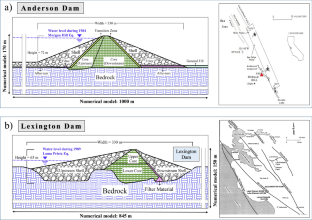
Data Availability
Enquiries about data availability should be directed to the authors.
Abbasi S, Seifollahi M, Daneshfaraz R, Mohammadi F, Abraham J, Abbaszadeh H (2023) Estimation of vertical settlement of earthen dams caused by earthquake using ANN model and wavelet-ANN composition. Geotech Geol Eng 41(5):3169–3186. https://doi.org/10.1007/s10706-023-02451-3
Article Google Scholar
Afsar Dizaj E, Kashani MM (2022) Influence of ground motion type on nonlinear seismic behaviour and fragility of corrosion-damaged reinforced concrete bridge piers. Bull Earthq Eng 20(3):1489–1518. https://doi.org/10.1007/s10518-021-01297-5
Ambraseys N, Douglas J (2003) Near-field horizontal and vertical earthquake ground motions. Soil Dyn Earthq Eng 23(1):1–18. https://doi.org/10.1016/S0267-7261(02)00153-7
Anderson TW, Darling DA (1954) A test of goodness of fit. J Am Stat Assoc 49(268):765–769. https://doi.org/10.1080/01621459.1954.10501232
Ansari A, Rao KS, Jain AK (2023) Seismic vulnerability of tunnels in Jammu and Kashmir for post seismic functionality. Geotech Geol Eng 41(2):1371–1396. https://doi.org/10.1007/s10706-022-02341-0
Argyroudis S, Kaynia AM, Pitilakis K (2013) Development of fragility functions for geotechnical constructions: application to cantilever retaining walls. Soil Dyn Earthq Eng 50:106–116. https://doi.org/10.1016/j.soildyn.2013.02.014
Bachmann D, Huber NP, Johann G, Schüttrumpf H (2013) Fragility curves in operational dike reliability assessment. Georisk 7(1):49–60. https://doi.org/10.1080/17499518.2013.767664
Baker JW (2007) Quantitative classification of near-fault ground motions using wavelet analysis. Bull Seismol Soc Am 97(5):1486–1501. https://doi.org/10.1785/0120060255
Bakun W, Clark M, Cockerham R, Ellsworth W, Lindh A, Prescott W, Shakal A, Spudich P (1984) The 1984 Morgan Hill, California, earthquake. Science 225(4659):288–291. https://doi.org/10.1126/science.225.4659.288
Article CAS Google Scholar
Baziar MH, Askari JS (2016) Geotechnical design of earth dams. In persian. Iran University of Science and Technology, Tehran, Iran
Google Scholar
CDWR (California Department of Water Resources) (2018) Inspection and Reevaluation Protocol. California, United States: CDWR, Division of Safety of Dams. Available at: https://water.ca.gov/Programs/All-Programs/Division-of-Safety-of-Dams .
Chen K, Pang R, Xu B (2023) Stochastic dynamic response and seismic fragility analysis for high concrete face rockfill dams considering earthquake and parameter uncertainties. Soil Dyn Earthq Eng 167:107817. https://doi.org/10.1016/j.soildyn.2023.107817
Chiou J-S, Chiang C-H, Yang H-H, Hsu S-Y (2011) Developing fragility curves for a pile-supported wharf. Soil Dyn Earthq Eng 31(5–6):830–840. https://doi.org/10.1016/j.soildyn.2011.01.011
D’Agostino R, Stephens M (1986) Goodness-of-fit-techniques (Statistics: a Series of Textbooks and Monographs, Vol. 68). Dekker.
Deviprasad B, Saseendran R, Dodagoudar G (2022) Fragility analysis of bridge pier supported on rocking shallow foundation under earthquake loading. Bull Earthq Eng 20(12):6901–6917. https://doi.org/10.1007/s10518-022-01463-3
Ellingwood B, Tekie PB (2001) Fragility analysis of concrete gravity dams. J Infrastruct Syst 7(2):41–48. https://doi.org/10.1061/(ASCE)1076-0342(2001)7:2(41)
FEMA (Federal Emergency Management Agency) (2005) Federal Guidelines for Dam Safety. United states: FEMA, Interagency committee on dam safety.
FERC (Federal Energy Regulatory Commission) (1991) Embankment Dams. United States: FERC, Office of Energy Projects, Division of Dam Safety and Inspections. http://www.ferc.gov/industries/hydropower/safety/guidelines/eng-guide/chap4.PDF
Gavabar SG, Alembagheri M (2020) A study on seismic performance and fragility of gravity dams with various monolith shapes using nonlinear IDA. Geotech Geol Eng 38(2):1133–1150. https://doi.org/10.1007/s10706-019-01077-8
GeoPentech T (2012) Seismic Stability Evaluations of Chesbro, Lenihan, Stevens Creek and Uvas Dams, Report No. LN-3. Lenihan Dam: Site Charaterization, Material, Properties and Ground Motions. U.S. Santa Clara Valley Water District, San Jose, CA 95118.
Gordan B, Raja MA, Armaghani DJ, Adnan A (2022) Review on dynamic behaviour of earth dam and embankment during an earthquake. Geotech Geol Eng 40(1):3–33. https://doi.org/10.1007/s10706-021-01919-4
Hariri-Ardebili MA, Saouma VE (2016a) Collapse fragility curves for concrete dams: comprehensive study. J Struct Eng 142(10):04016075. https://doi.org/10.1061/(ASCE)ST.1943-541X.0001541
Hariri-Ardebili MA, Saouma VE (2016b) Seismic fragility analysis of concrete dams: A state-of-the-art review. Eng Struct 128:374–399. https://doi.org/10.1016/j.engstruct.2016.09.034
Hayden CP, Bray JD, Abrahamson NA (2014) Selection of near-fault pulse motions. J Geotech Geoenviron Eng 140(7):04014030. https://doi.org/10.1061/(ASCE)GT.1943-5606.0001129
Hong-in P, Keawsawasvong S, Lai VQ, Nguyen TS, Tanapalungkorn W, Likitlersuang S (2023) 3D stability and failure mechanism of undrained clay slopes subjected to seismic load. Geotech Geol Eng 41(7):3941–3969. https://doi.org/10.1007/s10706-023-02497-3
Hoose S N (1987) The Morgan Hill, California, earthquake of April 24, 1984. US Government Printing Office.
Huang Z-K, Pitilakis K, Argyroudis S, Tsinidis G, Zhang D-M (2021) Selection of optimal intensity measures for fragility assessment of circular tunnels in soft soil deposits. Soil Dyn Earthq Eng 145:106724. https://doi.org/10.1016/j.soildyn.2021.106724
IBM (2019) IBM SPSS Statistics for Windows, version Version 26.0, Armonk, NY: IBM Corporation.
Iervolino I (2022) Estimation uncertainty for some common seismic fragility curve fitting methods. Soil Dyn Earthq Eng 152:107068. https://doi.org/10.1016/j.soildyn.2021.107068
IRC (Iran Code) (2013) Guideline for Seismic Analysis and Design of Earth & Rockfill Dams (Rep. No. 624). Iran, Tehran: Vice Presidency for Strategic Planning and Supervision, Office of Deputy for Strategic Supervision, Department of Technical Affairs.
IS (Indian standard) (2002) Indian standard criteria for earthquake resistant design of structures: Part 1 general provisions and buildings. New Delhi: Bureau of Indian Standards.
Itasca Consulting Group I (2011) FLAC - Fast Lagrangian Analysis of Continua, version 7th version, Minneapolis: Itasca.
Jafarian Y, Lashgari A, Miraiei M (2021) Multivariate fragility functions for seismic landslide hazard assessment. J Earthq Eng 25(3):579–596. https://doi.org/10.1080/13632469.2018.1528909
Karim KR, Yamazaki F (2001) Effect of earthquake ground motions on fragility curves of highway bridge piers based on numerical simulation. Earthq Eng Struct Dyn 30(12):1839–1856. https://doi.org/10.1002/eqe.97
Kuhlemeyer RL, Lysmer J (1973) Finite element method accuracy for wave propagation problems. J Soil Mech Found Div 99(5):421–427. https://doi.org/10.1061/JSFEAQ.0001885
Lagaros ND, Tsompanakis Y, Psarropoulos PN, Georgopoulos EC (2009) Computationally efficient seismic fragility analysis of geostructures. Comput Struct 87(19–20):1195–1203. https://doi.org/10.1016/j.compstruc.2008.12.001
Lallemant D, Kiremidjian A, Burton H (2015) Statistical procedures for developing earthquake damage fragility curves. Earthq Eng Struct Dyn 44(9):1373–1389. https://doi.org/10.1002/eqe.2522
Lendering K, Schweckendiek T, Kok M (2018) Quantifying the failure probability of a canal levee. Georisk 12(3):203–217. https://doi.org/10.1080/17499518.2018.1426865
Lin L, Adams J (2008) Seismic vulnerability and prioritization ranking of dams in Canada. In Proc., 14th world conference on earthquake engineering. Beijing, China.
Morales-Torres A, Escuder-Bueno I, Altarejos-García L, Serrano-Lombillo A (2016) Building fragility curves of sliding failure of concrete gravity dams integrating natural and epistemic uncertainties. Eng Struct 125:227–235. https://doi.org/10.1016/j.engstruct.2016.07.006
Pang R, Xu B, Zhou Y, Zhang X, Wang X (2020) Fragility analysis of high CFRDs subjected to mainshock-aftershock sequences based on plastic failure. Eng Struct 206:110152. https://doi.org/10.1016/j.engstruct.2019.110152
PEER (Pacific earthquake engineering research center) (2013) PEER NGA-West2 Database. http://peer.berkeley.edu/ngawest2 . http://peer.berkeley.edu/ngawest2
Porter K, Kennedy R, Bachman R (2007) Creating fragility functions for performance-based earthquake engineering. Earthq. Spectra, 23(2), 471–489.
Saeidi A, Eslami E, Quirion M, Seifaddini M (2020) Assessment of rock mass erosion in unlined spillways using developed vulnerability and fragility functions. Georisk 14(4):280–292. https://doi.org/10.1080/17499518.2019.1660796
Seed H, Idriss I (1970) Soil moduli and damping factors for dynamic analysis. Report No. EERC 70–10. University of California, Berkeley.
Shao W, He L, Shi D, Li L (2023) Seismic vulnerability assessment of deteriorating pile foundations in marine environments. Geotech Geol Eng 41(4):2467–2479. https://doi.org/10.1007/s10706-023-02409-5
Shapiro SS, Wilk MB (1965) An analysis of variance test for normality (complete samples). Biometrika 52(3/4):591–611. https://doi.org/10.2307/2333709
Sudret B, Mai C, Konakli K (2014) Assessment of the lognormality assumption of seismic fragility curves using non-parametric representations. arXiv preprint arXiv:1403.5481 . https://doi.org/10.48550/arXiv.1403.5481
Sun JI, Golesorkhi R, Seed HB (1988) Dynamic moduli and damping ratios for cohesive soils. University of California Berkeley, Earthquake Engineering Research Center
Talebi Mamoudan HR, Kalantary F, Derakhshandi M, Ganjian N (2021) Probabilistic and deterministic assessment of liquefaction potential using piezocone data. Geotech Geol Eng 39:533–547. https://doi.org/10.1007/s10706-020-01511-2
Thomopoulos C, Lai C (2012) Preliminary definition of fragility curves for pile-supported wharves. J Earthq Eng 16(sup1):83–106. https://doi.org/10.1080/13632469.2012.675839
Wang L, Wu C, Gu X, Liu H, Mei G, Zhang W (2020a) Probabilistic stability analysis of earth dam slope under transient seepage using multivariate adaptive regression splines. Bull Eng Geol Environ 79:2763–2775. https://doi.org/10.1007/s10064-020-01730-0
Wang L, Wu C, Tang L, Zhang W, Lacasse S, Liu H, Gao L (2020b) Efficient reliability analysis of earth dam slope stability using extreme gradient boosting method. Acta Geotech 15:3135–3150. https://doi.org/10.1007/s11440-020-00962-4
Zhang W-g, Meng F-s, Chen F-y, Liu H-l (2021) Effects of spatial variability of weak layer and seismic randomness on rock slope stability and reliability analysis. Soil Dyn Earthq Eng 146:106735. https://doi.org/10.1016/j.soildyn.2021.106735
Download references
The authors have not disclosed any funding.
Author information
Authors and affiliations.
School of Civil Engineering, Iran University of Science and Technology, Narmak, Tehran, 16846-13114, Iran
Mohammad Hassan Baziar & Seyed Meisam Alavi
You can also search for this author in PubMed Google Scholar
Corresponding author
Correspondence to Mohammad Hassan Baziar .
Ethics declarations
Conflict of interests.
The authors have no relevant financial or non-financial interests to disclose.
Additional information
Publisher's note.
Springer Nature remains neutral with regard to jurisdictional claims in published maps and institutional affiliations.
Rights and permissions
Springer Nature or its licensor (e.g. a society or other partner) holds exclusive rights to this article under a publishing agreement with the author(s) or other rightsholder(s); author self-archiving of the accepted manuscript version of this article is solely governed by the terms of such publishing agreement and applicable law.
Reprints and permissions
About this article
Baziar, M.H., Alavi, S.M. Seismic Assessment of Clayey-Core Earth Fill Dams Using Performance-Based Fragility Curves and Finite Difference Analyses. Geotech Geol Eng (2024). https://doi.org/10.1007/s10706-024-02800-w
Download citation
Received : 06 November 2023
Accepted : 06 April 2024
Published : 29 April 2024
DOI : https://doi.org/10.1007/s10706-024-02800-w
Share this article
Anyone you share the following link with will be able to read this content:
Sorry, a shareable link is not currently available for this article.
Provided by the Springer Nature SharedIt content-sharing initiative
- Clayey-core earth fill dams
- Performance-based fragility curves
- Peak ground acceleration ( PGA )
- Specific energy density ( SED )
- Arias intensity ( I a )
- Find a journal
- Publish with us
- Track your research

IMAGES
VIDEO
COMMENTS
The main difference between assignment and assessment is that assignments refer to the allocation of a task or set of tasks that are marked and graded while assessment refers to methods for establishing if students have achieved a learning outcome, or are on their way toward a learning objective. Assignments and assessment are two important ...
Understanding the differences between assignment and assessment can help educators make informed decisions about which to use in different situations. Assignments. Assignments are tasks given to students to complete outside of class time. They are typically designed to help students develop specific skills or knowledge and may be graded or ...
An assignment is typically a piece of work or task that is assigned to someone as part of a job or course of study. It's a designated task meant to be completed within a set timeframe. On the other hand, assessment is a tool utilized to evaluate, measure, and document the academic readiness, skill acquisition, or educational needs of students ...
Assignments and assessments are much the same thing: an instructor is unlikely to give students an assignment that does not receive some sort of assessment, whether formal or informal, formative or summative; and an assessment must be assigned, whether it is an essay, case study, or final exam.
An assignment may occasionally serve as an assessment tool. Formative and summative assessments are the two main types of assessment. Summative evaluation takes place after each learning unit, whereas formative evaluation is undertaken throughout the learning process. Assessment includes tests, assignments, group projects, quizzes, and summaries.
Essays are a common form of writing assignment in courses and can be either a summative or formative form of assessment depending on how the instructor utilizes them. ... other biases associated with identity (e.g., race, gender, or class) and personality differences can shape student assessments in unfair ways. Therefore, it is important for ...
An assessment may not come in a much different form to the assignment, but they are usually considered more important. This is because an assessment is the act of assessing the progress of your child. The assessment may be a take-home task, an exam/test, speech or something more hands-on. An assessment can be both in-class or at home.
Assessments for learning - also described as assessments as learning - assess a student's comprehension and understanding of a skill or lesson during the learning and teaching process. According to the Eberly Center at Carnegie Mellon, this provides educators with ongoing feedback and allows them to: Identify at-risk students early.
An assignment typically refers to a task, project, or duty given to someone, usually within an educational or work context. An assessment, conversely, is the act of evaluating or appraising someone's performance, skills, knowledge, or capabilities. Teachers often give students an assignment as part of their coursework, which they are expected ...
The purpose of the assessment is for the teacher to have an understanding of the student's skill level so they can create the best study plan for the student. An assignment is a free feature and works as either classwork or homework. It has a due date and the student will know their score immediately. The score is also added to the student's ...
An assessment will typically fulfill one of two general purposes. Formative assessments are designed to help you receive and give feedback that will promote further student learning. Summative assessments allow students to demonstrate their achievement of the learning objectives. The following table further highlights the differences.
The chapter begins by exploring the popular essay assignment, with its two common categories, ... Reports are a common form of assessment at university and are also used widely in many professions. It is a common form of writing in business, government, scientific, and technical occupations. ... There is a distinct difference (see Table 15.4 ...
Assessment Rubric. The assessment rubric, forms part of a set of criteria and refers specifically to the "levels of performance quality on the criteria." (Brookhart & Chen, 2015, p. 343) Generally, rubrics are categorised into two categories, holistic and or analytic. A holistic rubric assesses an assignment as a whole and is not broken ...
Assignments can be comprised of Assessments you have created or things such as Practice Tests, Video Lessons, and Practice Questions. The assignment builder is also the vehicle that you'll use to deliver your assessments to your students. Once you've created an assessment, you'll use the assignment builder to assign it to your students.
After exploring the differences between tests and assignments, it is clear that these two terms are not interchangeable. Tests are assessments that measure a student's knowledge and understanding of a particular topic, while assignments are tasks given to students to complete as a way to demonstrate their learning and application of skills.
An assignment is usually completed at home and submitted to the school after a certain period. The Assessment. An assessment may not come in a much different form to the assignment, but they are ...
Assignment Types play a key role when creating a new Assignment. Defined Assignment types are necessary for the Gradebook as you can assign specific weights to each one. Through Assignment types, you could create a Test assignment to represent work handed in and graded manually outside of the in-app assessment feature. Assessments.
Noun. ( wikipedia assessment ) ( en noun ) The act of assessing or an amount (of tax, levy or duty etc) assessed. An appraisal or evaluation. As nouns the difference between assignment and assessment is that assignment is the act of assigning; the allocation of a job or a set of tasks while assessment is...
The purpose of an assessment is to help the teacher evaluate a student's ability and level of curriculum compliance. As a result, an evaluation is a collaborative process focusing on learning and teaching. Sometimes, assignments can be used as a tool for assessment. The types of assessment are summative and formative.
Difference between Assignment and Assessment Assignment as a noun is the act of assigning, or an assigned task while Assessment as a noun is the act of assessing or an amount (of tax, levy or duty etc) assessed.
What do you mean by home assignment? To understand the difference between Assessment and assignment, it is essential to be well acquainted with both concepts.. An assignment outside of class time is known as a home assignment. For Example, students may be expected to complete a reading assignment, a writing or typing project, a set of math problems, study for a test, or work on other abilities.
Another common mistake is confusing "assignment" with "assessment." While both terms relate to tasks or projects, "assignment" refers to the task or project itself, while "assessment" refers to the evaluation or grading of the completed task or project. ... In conclusion, understanding the difference between assignment and ...
Assessment is made to identify the level of performance of an individual, whereas evaluation is performed to determine the degree to which goals are attained. The basic difference between assessment and evaluation lies in the orientation, i.e. while the assessment is process oriented, evaluation is product oriented.
Accounting document from University of Dubai, 5 pages, Assessment Instrument Cover Sheet Course Code: BACC 413 Course Title: Intermediate accounting 2 Semester: Spring Academic year: 2023-2024 Assessment Instrument: Assignment 2 Date: 30-05-2024 Course Instructor: Dr. Mohamed Kolsi College: DBS This instrumen
Kamala Harris' Secret Service team faced a violent threat this week, having to defend one of their agents ... from one of their own!!!
To reduce uncertainties regarding seismic loading scenarios and numerical modeling limitations, the performance-based fragility curves of two California clayey-core earth fill dams (the Anderson and Lexington dams) were developed for the first time using the results of over 170 finite difference seismic analyses. Permanent deformations were considered as the damage index (DI), and fragility ...